Editor's Note:
Dear Friend,
Imagine you were a forty-year-old poor illiterate shepherd who found it very difficult to learn. Let’s say you were inspired by the steady drip-drop of water making a hole in a hard rock and went off to learn Torah. After 24 years, you become one of the leading sages and attract 24,000 students.
Now, Imagine that one of your most important teachings was to “love your fellow as yourself.” But despite that, all 24,000 students die in a plague because they went against your most fundamental teaching. You started out very late in life, you were finally successful in learning, and now, in your twilight years, the continuation of your lifework is gone. what would you do?
Thank G‑d, Rabbi Akiva (the hero of this story), lived with the motto “it’s never too late.” He found five new students. These students (including Rabbi Shimon bar Yochai, whose passing is celebrated this thursday on Lag BaOmer) became some of the greatest sages of Israel, who ensured the continuance of Torah tradition.
We don’t need to wait until we're forty to study Torah. But even if we are already older, it’s never too late to study Torah.
So what are we waiting for?
Yehuda Shurpin
on behalf of the Chabad.org Editorial Team

Differences
Don’t be afraid of the other person because he is different from you. There is far more in common between any two human beings than there are differences.
As for the differences, think of them as the hooks that hold us together.
Differences are the thing we have most in common.
The Rebbe was talking to children and discussing relationships between Jews and non-Jews
This Week's Features:
Printable Magazine

Tiferet: When Kindness and Discipline Merge
Frank is the father of a young family. He was raised alone by an authoritarian father who administered harsh discipline. by Yaakov Feder The world of Kabbalah contains powerful lessons and guidelines that can be applied to the practical areas of self-development and personal growth. Although the Kabbalah primarily describes G‑dly revelation, the biblical verse states that man has been created “in the image of G‑d.”
The world of Kabbalah contains powerful lessons and guidelines that can be applied to the practical areas of self-development and personal growth. Although the Kabbalah primarily describes G‑dly revelation, the biblical verse states that man has been created “in the image of G‑d.”
One of the fundamental precepts of Kabbalah is the idea that the creation of the finite world is facilitated by means of Sefirot, divine attributes. G‑d creates the world and reveals Himself by enclothing His Infinite Light in ten attributes that parallel human characteristics. These attributes, or Sefirot, contain G‑dly revelation within defined areas of intellect, emotion, and expression.
By grasping the meaning of the Kabbalistic Sefirot, we begin to understand ourselves better. Ironically, in our quest to know G‑d we end up knowing much more about ourselves. Let us examine the emotional attribute of Tiferet, harmonized emotion, from an excerpt from the new book The Sefiros and the Self: A Divine Blueprint for Self-Discovery and Personal Growth.
Case Study
Frank is the father of a young family. He was raised alone by an authoritarian father who administered harsh discipline. Although he now has a loving wife and a comfortable environment, he retains many of the attitudes and approaches of his upbringing. Frank has very definite ideas about how a household should be run, and accordingly there are a series of rules and regulations which must be adhered to. Any divergence from his rigid set of rules leads to anger and harsh discipline. Like a drill sergeant, his approach is “my way or the highway.”
This parenting style has created a level of success in the management of the home: the children follow the rules, there is an adherence to strict bedtimes, and chores are done quickly and without any backtalk. The household is organized and efficient, but the success is on a narrow spectrum. The relationship between father and children is superficial (“Did you do your homework?” “Yes, Dad”). The children do not feel a deeper and more loving connection with him. There is a spirit of rebellion in the air and a total lack of enthusiasm for his initiatives.
Furthermore, as a result of his ideas about competition and toughness, which pit one child against another, there is a sense of overall distrust and tension in the home. The dynamics between mother and children are also affected by the father’s rigidity; he frowns upon her displays of love and affection, telling her that this will spoil the children. Love has become a scarce resource in this house, and the effect is like a slow poison.
Eventually, Frank begins to recognize that he is failing as a parent. While he may have gained the obedience of his family, he has not won their hearts. Where has he gone wrong?
Diagnosis
The attribute of tiferet is translated literally as “beauty.” The beauty of tiferet is in its ability to blend two opposites: chesed and gevurah. Pure chesed is the unbridled expansiveness of giving; pure gevurah is the total opposite: restraint, caution and control. Tiferet is the ideal blend, expansiveness that is balanced with control, trust with caution, and giving with restraint.
How does tiferet work?
The Kabbalistic masters explain that both kindness and restraint are primarily inwardly driven: they are motivated by an internal need and tendency. The expansiveness and kindness of the chesed-oriented person is based on his need to give. He enjoys the experience of giving and expressing love. This is what makes him feel alive. Kindness is more about the need of the giver to give than it is about the receiver to receive the gift. As such, the kindness may not always fit the actual need of the receiver. As in the case of a spoiled child, the boundless nature of kindness can sometimes lead to harmful consequences.
The same is true with regard to a restraint-oriented individual, who is most comfortable in a highly structured, regulated environment. Even when the rules make little sense, there is a tendency to enforce them without flexibility. Think of low-level bureaucrats and the great pleasure they take in enforcing inconsequential rules. Restraint, when taken to an extreme, is driven by a need to exert control even when it may detrimentally affect the situation.
In contrast, tiferet is driven externally. Tiferet is the desire to connect and form a meaningful relationship with another. Tiferet, therefore, listens for feedback from the other person before deciding what and how to give. Without hearing the response of the other person, there can only be a superficial connection between them. Whereas chesed may give a large, rich meal to a pauper whose stomach cannot handle rich food, tiferet will be sensitive to the pauper’s unique needs and will serve a meal that is appropriate.The approaches of both kindness and restraint tend to be one-sided, rooted as they are in their own bias. Tiferet is called the attribute of truth, due to its ability to overcome bias and personal perceptions and discover the ideal method of connectivity and resolution.
Frank’s problem in relating to his family stems from his overemphasis on restraint. His own life experience and personality have set him on a path of rigid control and lack of empathy. In order to create a more meaningful relationship with his family, he will need to develop the empathy, connectivity and balance that is tiferet.
This can be treated in three steps.
The Time-Out: Stepping Outside Oneself
The first step in transitioning to tiferet begins with the awareness that we don’t have all the answers. Most of us have a tendency to assume that our approach to a given situation is the correct one. We have a natural bias toward a particular methodology based on our personality and our past experiences, and we tend to repeat this approach time and again.
Tiferet begins by asking the question: What if my natural approach to this problem is missing the point? What does this particular situation call for? Frank must stop saying to himself, “This worked for my father and my other children, and it will work for this child too!” Instead, he must take a timeout and think, Perhaps there is another way to handle this that will lead to better results. This willingness to take a timeout, to go against one’s natural flow and bias, is the beginning of tiferet.
Dialogue: Empathy
Step two requires that Frank enter into a dialogue with his family. They must feel more comfortable expressing themselves in their relationship with their father. He must create a time and place for interacting with them in a non-threatening, non-judgmental atmosphere. There the children can feel freer to be themselves, expressing their hopes, dreams, desires and ideas.
This does not need to be a focused process of negotiating specific points or procedures in the home. On the contrary, the concept of dialogue begins with a sense of comfort and safety, which is a platform for trust.
Just as a business negotiation may take place in a coffee shop or restaurant, and begin with some informal getting-to-know-each-other conversation, so too Frank’s interaction with his family must first ease some of the tension. Playing a game with the children is one way to do this. Once the children are more comfortable being with their father, there will be a looser, easier environment.
Eventually there can be a more open and honest dialogue between them. Frank can express his goals and concerns for his family in a broader sense, and the children can express their own perspective. This back-and-forth is akin to a process of negotiation, in which each party must fully express its interests and concerns. If the negotiation is handled with empathy and goodwill, a harmonious conclusion will ensue. As preconceptions are put aside, a willingness to work together is born.
The family can eventually join together to create a synergy—to find solutions that will balance Frank’s goals and concerns with the needs of his children.
Fusion: Discovering a Deeper Connection
Fusion and connectivity can occur only after establishing dialogue and rapport. Most people can intuitively sense when they are connecting with another person or when the conversation is flat and two-dimensional. This can be observed when a couple is on a date, meeting each other for the first time. The conversation may at first be stilted and awkward or superficial. However, a turning point can take place whereby a connection is made and there is an intensified engagement of the emotions. There is a moment when things begin to “click.” We cannot force these moments to take place. However, by creating platforms of dialogue, exploration, sensitivity and listening, achieving the desired connectivity and fusion becomes a real possibility.
For Frank and his family, step three is the moment of transition to connectivity and fusion. Having created a dialogue with his family, they are now secure in sharing their differing perspectives. As they engage in this conversation, they must seek to identify the point of connection, the “click” that will allow them to fuse together and find directions that they can all be enthusiastic about.
This synergy must be intuitively discovered. Frank must remain alert to the possibilities, and more importantly, believe that a higher level of connectivity is possible. Once Frank identifies a point of connectivity, it will lead to further forms of connection, wherein the family can explore a rewarding relationship.
By utilizing these tools in his interactions to his own family dynamics, Frank will achieve tiferet, with all of its connotations of harmony, balance, integration and beauty.
-------

Tiferet: When Kindness and Discipline Merge
Frank is the father of a young family. He was raised alone by an authoritarian father who administered harsh discipline. by Yaakov Feder
 The world of Kabbalah contains powerful lessons and guidelines that can be applied to the practical areas of self-development and personal growth. Although the Kabbalah primarily describes G‑dly revelation, the biblical verse states that man has been created “in the image of G‑d.”
The world of Kabbalah contains powerful lessons and guidelines that can be applied to the practical areas of self-development and personal growth. Although the Kabbalah primarily describes G‑dly revelation, the biblical verse states that man has been created “in the image of G‑d.”One of the fundamental precepts of Kabbalah is the idea that the creation of the finite world is facilitated by means of Sefirot, divine attributes. G‑d creates the world and reveals Himself by enclothing His Infinite Light in ten attributes that parallel human characteristics. These attributes, or Sefirot, contain G‑dly revelation within defined areas of intellect, emotion, and expression.
By grasping the meaning of the Kabbalistic Sefirot, we begin to understand ourselves better. Ironically, in our quest to know G‑d we end up knowing much more about ourselves. Let us examine the emotional attribute of Tiferet, harmonized emotion, from an excerpt from the new book The Sefiros and the Self: A Divine Blueprint for Self-Discovery and Personal Growth.
Case Study
Frank is the father of a young family. He was raised alone by an authoritarian father who administered harsh discipline. Although he now has a loving wife and a comfortable environment, he retains many of the attitudes and approaches of his upbringing. Frank has very definite ideas about how a household should be run, and accordingly there are a series of rules and regulations which must be adhered to. Any divergence from his rigid set of rules leads to anger and harsh discipline. Like a drill sergeant, his approach is “my way or the highway.”
This parenting style has created a level of success in the management of the home: the children follow the rules, there is an adherence to strict bedtimes, and chores are done quickly and without any backtalk. The household is organized and efficient, but the success is on a narrow spectrum. The relationship between father and children is superficial (“Did you do your homework?” “Yes, Dad”). The children do not feel a deeper and more loving connection with him. There is a spirit of rebellion in the air and a total lack of enthusiasm for his initiatives.
Furthermore, as a result of his ideas about competition and toughness, which pit one child against another, there is a sense of overall distrust and tension in the home. The dynamics between mother and children are also affected by the father’s rigidity; he frowns upon her displays of love and affection, telling her that this will spoil the children. Love has become a scarce resource in this house, and the effect is like a slow poison.
Eventually, Frank begins to recognize that he is failing as a parent. While he may have gained the obedience of his family, he has not won their hearts. Where has he gone wrong?
Diagnosis
The attribute of tiferet is translated literally as “beauty.” The beauty of tiferet is in its ability to blend two opposites: chesed and gevurah. Pure chesed is the unbridled expansiveness of giving; pure gevurah is the total opposite: restraint, caution and control. Tiferet is the ideal blend, expansiveness that is balanced with control, trust with caution, and giving with restraint.
How does tiferet work?
The Kabbalistic masters explain that both kindness and restraint are primarily inwardly driven: they are motivated by an internal need and tendency. The expansiveness and kindness of the chesed-oriented person is based on his need to give. He enjoys the experience of giving and expressing love. This is what makes him feel alive. Kindness is more about the need of the giver to give than it is about the receiver to receive the gift. As such, the kindness may not always fit the actual need of the receiver. As in the case of a spoiled child, the boundless nature of kindness can sometimes lead to harmful consequences.
The same is true with regard to a restraint-oriented individual, who is most comfortable in a highly structured, regulated environment. Even when the rules make little sense, there is a tendency to enforce them without flexibility. Think of low-level bureaucrats and the great pleasure they take in enforcing inconsequential rules. Restraint, when taken to an extreme, is driven by a need to exert control even when it may detrimentally affect the situation.
In contrast, tiferet is driven externally. Tiferet is the desire to connect and form a meaningful relationship with another. Tiferet, therefore, listens for feedback from the other person before deciding what and how to give. Without hearing the response of the other person, there can only be a superficial connection between them. Whereas chesed may give a large, rich meal to a pauper whose stomach cannot handle rich food, tiferet will be sensitive to the pauper’s unique needs and will serve a meal that is appropriate.The approaches of both kindness and restraint tend to be one-sided, rooted as they are in their own bias. Tiferet is called the attribute of truth, due to its ability to overcome bias and personal perceptions and discover the ideal method of connectivity and resolution.
Frank’s problem in relating to his family stems from his overemphasis on restraint. His own life experience and personality have set him on a path of rigid control and lack of empathy. In order to create a more meaningful relationship with his family, he will need to develop the empathy, connectivity and balance that is tiferet.
This can be treated in three steps.
The Time-Out: Stepping Outside Oneself
The first step in transitioning to tiferet begins with the awareness that we don’t have all the answers. Most of us have a tendency to assume that our approach to a given situation is the correct one. We have a natural bias toward a particular methodology based on our personality and our past experiences, and we tend to repeat this approach time and again.
Tiferet begins by asking the question: What if my natural approach to this problem is missing the point? What does this particular situation call for? Frank must stop saying to himself, “This worked for my father and my other children, and it will work for this child too!” Instead, he must take a timeout and think, Perhaps there is another way to handle this that will lead to better results. This willingness to take a timeout, to go against one’s natural flow and bias, is the beginning of tiferet.
Dialogue: Empathy
Step two requires that Frank enter into a dialogue with his family. They must feel more comfortable expressing themselves in their relationship with their father. He must create a time and place for interacting with them in a non-threatening, non-judgmental atmosphere. There the children can feel freer to be themselves, expressing their hopes, dreams, desires and ideas.
This does not need to be a focused process of negotiating specific points or procedures in the home. On the contrary, the concept of dialogue begins with a sense of comfort and safety, which is a platform for trust.
Just as a business negotiation may take place in a coffee shop or restaurant, and begin with some informal getting-to-know-each-other conversation, so too Frank’s interaction with his family must first ease some of the tension. Playing a game with the children is one way to do this. Once the children are more comfortable being with their father, there will be a looser, easier environment.
Eventually there can be a more open and honest dialogue between them. Frank can express his goals and concerns for his family in a broader sense, and the children can express their own perspective. This back-and-forth is akin to a process of negotiation, in which each party must fully express its interests and concerns. If the negotiation is handled with empathy and goodwill, a harmonious conclusion will ensue. As preconceptions are put aside, a willingness to work together is born.
The family can eventually join together to create a synergy—to find solutions that will balance Frank’s goals and concerns with the needs of his children.
Fusion: Discovering a Deeper Connection
Fusion and connectivity can occur only after establishing dialogue and rapport. Most people can intuitively sense when they are connecting with another person or when the conversation is flat and two-dimensional. This can be observed when a couple is on a date, meeting each other for the first time. The conversation may at first be stilted and awkward or superficial. However, a turning point can take place whereby a connection is made and there is an intensified engagement of the emotions. There is a moment when things begin to “click.” We cannot force these moments to take place. However, by creating platforms of dialogue, exploration, sensitivity and listening, achieving the desired connectivity and fusion becomes a real possibility.
For Frank and his family, step three is the moment of transition to connectivity and fusion. Having created a dialogue with his family, they are now secure in sharing their differing perspectives. As they engage in this conversation, they must seek to identify the point of connection, the “click” that will allow them to fuse together and find directions that they can all be enthusiastic about.
This synergy must be intuitively discovered. Frank must remain alert to the possibilities, and more importantly, believe that a higher level of connectivity is possible. Once Frank identifies a point of connectivity, it will lead to further forms of connection, wherein the family can explore a rewarding relationship.
By utilizing these tools in his interactions to his own family dynamics, Frank will achieve tiferet, with all of its connotations of harmony, balance, integration and beauty.
-------
THIS THURSDAY: LAG BAOMER

Thirteen Years in a Cave, Now What?
They wallowed in sand, subsisting only on carobs and water. They exit after thirteen years. What is the first thing on Rabbi Shimon’s agenda? by Levi AvtzonWhat’s the first thing you do after you leave the cave you’ve been hiding in for the past thirteen years?
You spend some time with your family (which hopefully has not deserted you).
Arrange a news conference.
Sign a book deal.
Negotiate a major motion picture.
Make the front cover of every tabloid magazine.
End up in rehab.
If you are of more humble stock, you try to return to your humble life, and count your blessings for years to come.
Sentenced A person “inconvenienced” by living in a cave for thirteen years would presumably scoff at the younger generation who call every triviality a traumato death after talking against the Roman regime, Rabbi Shimon bar Yochai hid in a cave for thirteen years together with his sonElazar. For thirteen years they wallowed in sand—they were filled with painful sores upon exiting—subsisting only on carobs and water from a tree and stream that miraculously appeared at the cave’s entrance. (Click here for the story, as told in the Talmud.)
They exit after thirteen years. What is the first thing on Rabbi Shimon’s agenda?
The townspeople tell him about a road under which there is a lost grave. Askohanim (priests) are not permitted to come in contact with a corpse, or even pass over one, they had to take a detour when wishing to travel that route. Rabbi Shimon discerns the location of the body, the grave is marked and the problem corrected.
Think about it.
A person who was “inconvenienced” by living in a cave for thirteen years would presumably feel that he has a monopoly on pain and discomfort, and scoff at the younger generation who call every triviality a trauma.
To try to ease their pain? Forget it.
But here we find Rabbi Shimon doing just that, spending his first moments of freedom helping some kohanim get rid of a relatively small inconvenience!
Is there nothing bigger and more important than helping a person with some minor nuisance after being locked up in a cave for almost a decade and a half?
No, there isn’t.

Thirteen Years in a Cave, Now What?
They wallowed in sand, subsisting only on carobs and water. They exit after thirteen years. What is the first thing on Rabbi Shimon’s agenda? by Levi AvtzonWhat’s the first thing you do after you leave the cave you’ve been hiding in for the past thirteen years?
You spend some time with your family (which hopefully has not deserted you).
Arrange a news conference.
Sign a book deal.
Negotiate a major motion picture.
Make the front cover of every tabloid magazine.
End up in rehab.
If you are of more humble stock, you try to return to your humble life, and count your blessings for years to come.
Sentenced A person “inconvenienced” by living in a cave for thirteen years would presumably scoff at the younger generation who call every triviality a traumato death after talking against the Roman regime, Rabbi Shimon bar Yochai hid in a cave for thirteen years together with his sonElazar. For thirteen years they wallowed in sand—they were filled with painful sores upon exiting—subsisting only on carobs and water from a tree and stream that miraculously appeared at the cave’s entrance. (Click here for the story, as told in the Talmud.)
They exit after thirteen years. What is the first thing on Rabbi Shimon’s agenda?
The townspeople tell him about a road under which there is a lost grave. Askohanim (priests) are not permitted to come in contact with a corpse, or even pass over one, they had to take a detour when wishing to travel that route. Rabbi Shimon discerns the location of the body, the grave is marked and the problem corrected.
Think about it.
A person who was “inconvenienced” by living in a cave for thirteen years would presumably feel that he has a monopoly on pain and discomfort, and scoff at the younger generation who call every triviality a trauma.
To try to ease their pain? Forget it.
But here we find Rabbi Shimon doing just that, spending his first moments of freedom helping some kohanim get rid of a relatively small inconvenience!
Is there nothing bigger and more important than helping a person with some minor nuisance after being locked up in a cave for almost a decade and a half?
No, there isn’t.
-------

The Holiday With a Funny Name
I tried saying it effortlessly, like I'd been saying it all my life… by Lieba Rudolph
“We’re going to New York for the Lag BaOmer parade,” I announced to my parents 28 years ago.
I figured, my parents knew what “New York” and “parade” were—maybe they would just let the “Lag BaOmer” part slide. Because if they asked me what Lag BaOmer was, my answer sounded like it was coming from someone else. Less than one year earlier, aI tried saying it effortlessly “log” was something you put in a fire, and I had no idea what a “BaOmer” was. I just knew it sounded too funny to say with a completely straight face.
Still, I needed to tell my parents something about the reason for my trip. So I repeated what I had learned from our rabbi: “Lag BaOmer is the day Rabbi Akiva’s students stopped dying, so it’s a day of celebration.” This would be my ready reply for years to anyone who asked about the holiday.
Of course, there was no fooling my parents back then. They knew and I knew that Rabbi Akiva and his students meant nothing to any of us, including me.
So why did our family follow the Rosenfelds, our rabbinic family in Pittsburgh, on a drive to New York (not Manhattan, mind you—Brooklyn!) to participate in a holiday that we knew nothing about? We had absolutely no frame of reference for it—no historical context, no experiences, no deeper lessons—gornisht. As in, nothing.
Partly, I wanted to go out of curiosity: Could “fun” and “Jewish” actually go together? But I also went because I wanted to know more. About Judaism. About my heritage. About a holiday with a funny name that had been on the Jewish calendar for thousands of years, yet had been on mine for less than one.
I can’t say that Lag BaOmer really resonated with me at the beginning. There aren’t any mitzvahs associated with the holiday. You don’t have to say certain prayers or eat certain foods. Our community holds a picnic celebration, but there’s nothing you have to do because it’s Lag BaOmer. Which means it was easy to dismiss Lag BaOmer as a “minor holiday,” especially during those years when providing my children with the basics of Judaism was already a huge commitment.
It’sIt’s easy to dismiss Lag BaOmer as a “minor holiday” only recently, since the fog of child-raising has lifted, that I can absorb more of the holiday’s significance. It’s hard to believe I missed it all these years. Because Lag BaOmer is also the yahrtzeit (anniversary of passing) of Rabbi Shimon bar Yochai, who authored the Zohar, the first book of Jewish mysticism. Rabbi Shimonunlocked the soul of Judaism in the second century, although only the most spiritually enlightened were allowed access to it. Today the Zohar’s essence flows through the teachings of Chassidism, with its wellsprings of self-knowledge available to any Jew, in any language, at any time. Rabbi Shimon opened the spiritual channel for us to know that G‑d is One. And that we are all created with an essential purpose—to reveal that Oneness.
“BaOmer” may always sound a little funny to me, but I’ve been nourished by these wellsprings, and I can honestly say that they have made all the difference in my life.
-------

Loving Yourself to Love Others
Her father disowned her, she lost her social status in the community, she lost her friends and her neighbors. by Elana Mizrahi
So often in my practice, I see women who don’t recognize the need to love and take care of themselves. The young mother who goes the entire day without eating because she’s “too busy nursing and feeding her baby” to prepare food for herself. The teenager who is constantly preoccupied with the need to “lose those five pounds” in order to feel like she fits in with her friends. The busy career woman who has “no time to exercise, no time to stop or breathe, let aloneShe lost her social status in the community think” because her day is full of clients and meetings. The woman who juggles work, family and community responsibilities, afraid to ask for help, lest the world know that she’s not perfect—and so she juggles until she drops a ball. Women who don’t sleep properly, don’t eat properly, don’t exercise properly. Women who have no time or energy to pray or go to an uplifting class. Beautiful, lovely women who spend their entire day giving and doing for everyone but themselves . . .
The Talmud describes a famous love story between a poor, unlearned shepherd named Akiva, and Rachel, the beautiful, intelligent daughter of one of the wealthiest men in Israel. When Rachel married Akiva, Rachel’s father disowned her; she lost her social status in the community; she lost her friends and her neighbors. I’m sure that all this pained Rachel a great deal, but given the fact that Rachel stayed loyal to Akiva and was extremely supportive of him, she must have had a strong sense of self-esteem. As much as her neighbors tried to destroy her, Rachel stood firm.
When they were first married, Rachel encouraged her 40-year-old husband to go to school. Now, we’re not talking about encouraging someone with a college degree to return for an advanced degree. We’re not even talking about encouraging someone with a high-school diploma to go to a trade school. Akiva had never been to school. He didn’t even know how to read. With Rachel’s encouragement, he went to school to learn the alef-beit. Imagine a 40-year-old man sitting with preschoolers. A pretty funny sight, no? The children laughed at Akiva, and he came home discouraged.
What did Rachel do? The Midrash1 tells us that she put pots of dirt on her donkey, and planted seeds inside the pots. Every day she watered the pots until a little garden grew on the donkey’s back. When the plants were fully grown, she turned to Akiva and asked, “Can you please go to the market and buy us some flour? I ran out.”
He went toHe returned thoroughly embarrassed the market with the donkey. Everyone who passed by laughed when they saw the donkey, and mocked Akiva. He returned home thoroughly embarrassed. The next day, Rachel said, “Akiva, we are out of lentils. Please go buy some.” He didn’t want to go back to the market with the donkey, but she insisted. Every day Rachel would find a new reason to send Akiva back to the market with the silly-looking donkey. The children mocked, the women stared, the men laughed and jeered. But each day the mocking, the staring, the laughing and the jeering lessened. By wintertime, no one even gave the funny-looking donkey a second thought, as they had become accustomed and indifferent to the sight.
“Hmmm,” thought Akiva. “No one even cares anymore.” He reflected on this, and with the encouragement and blessing of his wife, he went back to school. At first the children laughed at the old man cramming his legs into the little desk, but soon they became accustomed to the sight, and the laughing stopped. Rabbi Akiva stayed in school, and then went off to study in the great centers of learning for 24 years, becoming one of the most esteemed and famous scholars of all time. When he returned home with his 24,000 students, he stood before them and said: “Everything I have (all my learning and insights and teaching) is because of her (Rachel); all you have (from being my pupils) is because of her.”
And what is Rabbi Akiva’s most famous teaching? That an absolutely fundamental principle of the Torah is to “Love your fellow as yourself.” How can you love your fellow? By loving yourself first! Through Rachel, Rabbi Akiva learned that the way to love and be close to another is by first loving and respecting yourself. If there is no self-love—no recognition of the beautiful and holy spark within—there’s no way you can truly love or give to another.
If you don’t feed yourself, take care of yourself, know your physical limitations, you simply won’t have what to give. I tell new mothers, “You need to eat and to sleep in order to take care of yourKnow your physical limitations baby.” The taking care of and loving of oneself is actually a prerequisite for all that we do, not an impediment.
A person who always worries about what others are thinking, a person who bases her feelings of self-worth on superficialities, will never be happy with herself—and she’ll then have a hard time being happy with those around her. She won’t be able to appreciate all the beauty and holiness that G‑d has created her with, and this will affect her ability to see the goodness within her fellow.
I tell my clients—and myself—“Value yourself! Accept yourself! Grow and learn from challenges and mistakes, but don’t beat yourself up over them. Be kind to yourself! Love yourself!”
Love your fellow as yourself, but first love yourself!
FOOTNOTES
1.Midrash HaGadol, Exodus 4:68.

Loving Yourself to Love Others
Her father disowned her, she lost her social status in the community, she lost her friends and her neighbors. by Elana Mizrahi
So often in my practice, I see women who don’t recognize the need to love and take care of themselves. The young mother who goes the entire day without eating because she’s “too busy nursing and feeding her baby” to prepare food for herself. The teenager who is constantly preoccupied with the need to “lose those five pounds” in order to feel like she fits in with her friends. The busy career woman who has “no time to exercise, no time to stop or breathe, let aloneShe lost her social status in the community think” because her day is full of clients and meetings. The woman who juggles work, family and community responsibilities, afraid to ask for help, lest the world know that she’s not perfect—and so she juggles until she drops a ball. Women who don’t sleep properly, don’t eat properly, don’t exercise properly. Women who have no time or energy to pray or go to an uplifting class. Beautiful, lovely women who spend their entire day giving and doing for everyone but themselves . . .
The Talmud describes a famous love story between a poor, unlearned shepherd named Akiva, and Rachel, the beautiful, intelligent daughter of one of the wealthiest men in Israel. When Rachel married Akiva, Rachel’s father disowned her; she lost her social status in the community; she lost her friends and her neighbors. I’m sure that all this pained Rachel a great deal, but given the fact that Rachel stayed loyal to Akiva and was extremely supportive of him, she must have had a strong sense of self-esteem. As much as her neighbors tried to destroy her, Rachel stood firm.
When they were first married, Rachel encouraged her 40-year-old husband to go to school. Now, we’re not talking about encouraging someone with a college degree to return for an advanced degree. We’re not even talking about encouraging someone with a high-school diploma to go to a trade school. Akiva had never been to school. He didn’t even know how to read. With Rachel’s encouragement, he went to school to learn the alef-beit. Imagine a 40-year-old man sitting with preschoolers. A pretty funny sight, no? The children laughed at Akiva, and he came home discouraged.
What did Rachel do? The Midrash1 tells us that she put pots of dirt on her donkey, and planted seeds inside the pots. Every day she watered the pots until a little garden grew on the donkey’s back. When the plants were fully grown, she turned to Akiva and asked, “Can you please go to the market and buy us some flour? I ran out.”
He went toHe returned thoroughly embarrassed the market with the donkey. Everyone who passed by laughed when they saw the donkey, and mocked Akiva. He returned home thoroughly embarrassed. The next day, Rachel said, “Akiva, we are out of lentils. Please go buy some.” He didn’t want to go back to the market with the donkey, but she insisted. Every day Rachel would find a new reason to send Akiva back to the market with the silly-looking donkey. The children mocked, the women stared, the men laughed and jeered. But each day the mocking, the staring, the laughing and the jeering lessened. By wintertime, no one even gave the funny-looking donkey a second thought, as they had become accustomed and indifferent to the sight.
“Hmmm,” thought Akiva. “No one even cares anymore.” He reflected on this, and with the encouragement and blessing of his wife, he went back to school. At first the children laughed at the old man cramming his legs into the little desk, but soon they became accustomed to the sight, and the laughing stopped. Rabbi Akiva stayed in school, and then went off to study in the great centers of learning for 24 years, becoming one of the most esteemed and famous scholars of all time. When he returned home with his 24,000 students, he stood before them and said: “Everything I have (all my learning and insights and teaching) is because of her (Rachel); all you have (from being my pupils) is because of her.”
And what is Rabbi Akiva’s most famous teaching? That an absolutely fundamental principle of the Torah is to “Love your fellow as yourself.” How can you love your fellow? By loving yourself first! Through Rachel, Rabbi Akiva learned that the way to love and be close to another is by first loving and respecting yourself. If there is no self-love—no recognition of the beautiful and holy spark within—there’s no way you can truly love or give to another.
If you don’t feed yourself, take care of yourself, know your physical limitations, you simply won’t have what to give. I tell new mothers, “You need to eat and to sleep in order to take care of yourKnow your physical limitations baby.” The taking care of and loving of oneself is actually a prerequisite for all that we do, not an impediment.
A person who always worries about what others are thinking, a person who bases her feelings of self-worth on superficialities, will never be happy with herself—and she’ll then have a hard time being happy with those around her. She won’t be able to appreciate all the beauty and holiness that G‑d has created her with, and this will affect her ability to see the goodness within her fellow.
I tell my clients—and myself—“Value yourself! Accept yourself! Grow and learn from challenges and mistakes, but don’t beat yourself up over them. Be kind to yourself! Love yourself!”
Love your fellow as yourself, but first love yourself!
FOOTNOTES
1.Midrash HaGadol, Exodus 4:68.
-------

Everything You Want to Know About Lag BaOmer
The birthday of Jewish mysticism . . . The spiritual significance of the bow and arrow . . . Can love be true, and can truth be loving? . . . What is Kabbalah?

Lag BaOmer, the 33rd day of theOmer count—this year, May 26, 2016—is a festive day on the Jewish calendar. It is celebrated with outings (on which the children traditionally play with bows and arrows), bonfires, and other joyous events. Many visit the resting place (in Meron, northernIsrael) of the great sage and mystic Rabbi Shimon bar Yochai, the anniversary of whose passing is on this day.
Rabbi Shimon bar Yochai, who lived in the second century of the common era, was the first to publicly teach the mystical dimension of theTorah known as the “Kabbalah,” and is the author of the basic work of Kabbalah, the Zohar. On the day of his passing, Rabbi Shimon instructed his disciples to mark the date as “the day of my joy.”
The chassidic masters explain that the final day of a righteous person’s earthly life marks the point at which “all his deeds, teachings and work” achieve their culminating perfection and the zenith of their impact upon our lives. So each Lag BaOmer, we celebrate Rabbi Shimon’s life and the revelation of the esoteric soul of Torah.
Lag BaOmer also commemorates another joyous event. The Talmud relates that in the weeks between the Jewish holidays of Passover and Shavuot, a plague raged amongst the disciples of the great sage Rabbi Akiva, “because they did not act respectfully towards each other.” These weeks are therefore observed as a period of mourning, with various joyous activities proscribed by law and custom. On Lag BaOmer the deaths ceased. Thus, Lag BaOmer also carries the theme of the imperative to love and respect one’s fellow (ahavat yisrael).
See also:
Lag BaOmer Traditions and Customs
Lag BaOmer Event Search
© Copyright, all rights reserved. If you enjoyed this article, we encourage you to distribute it further, provided that you comply with Chabad.org's copyright policy.


What Is Lag BaOmer?
The Chassidic masters explain that the final day of a person’s earthly life marks the point when “all his deeds, teachings and work” achieve their culminating perfection . . .

Lag BaOmer Customs and Traditions by Naftali Silberberg
Bonfires, Jewish Unity parades, bows and arrows, carobs and more. Find out what is traditionally done on Lag BaOmer, and why . . .

Lag BaOmer Event Search
Find Lag BaOmer Events Near You
Parades, picnics, bonfires, outings... Find out which fun programs YOUR local Chabad center is offering this Lag BaOmer!

Lag BaOmer Insights
24,000 Plus One
Kabbalah of the Bow and Arrow
The Practical Implications of Infinity
View All 19

History
Rabbi Shimon Bar Yochai
Rabbi Akiba
The History of Lag BaOmer

Lag BaOmer Questions & Answers
What Is Lag BaOmer?
Celebrate on the Anniversary of Death?
Why the Bow and Arrow on Lag BaOmer?
View All 6

Stories
A Carob Tree and a Spring
Lag BaOmer Parade
Miracle in Meron
View All 6

AudioLag BaOmer Audio Classes
What is Lag BaOmer?
A History of Lag BaOmer
What is a Tzadik?
View All 8

Lag BaOmer Videos

11 Recipes to Make for Lag BaOmer by Miriam Szokovski


Everything You Want to Know About Lag BaOmer
The birthday of Jewish mysticism . . . The spiritual significance of the bow and arrow . . . Can love be true, and can truth be loving? . . . What is Kabbalah?

Lag BaOmer, the 33rd day of theOmer count—this year, May 26, 2016—is a festive day on the Jewish calendar. It is celebrated with outings (on which the children traditionally play with bows and arrows), bonfires, and other joyous events. Many visit the resting place (in Meron, northernIsrael) of the great sage and mystic Rabbi Shimon bar Yochai, the anniversary of whose passing is on this day.
Rabbi Shimon bar Yochai, who lived in the second century of the common era, was the first to publicly teach the mystical dimension of theTorah known as the “Kabbalah,” and is the author of the basic work of Kabbalah, the Zohar. On the day of his passing, Rabbi Shimon instructed his disciples to mark the date as “the day of my joy.”
The chassidic masters explain that the final day of a righteous person’s earthly life marks the point at which “all his deeds, teachings and work” achieve their culminating perfection and the zenith of their impact upon our lives. So each Lag BaOmer, we celebrate Rabbi Shimon’s life and the revelation of the esoteric soul of Torah.
Lag BaOmer also commemorates another joyous event. The Talmud relates that in the weeks between the Jewish holidays of Passover and Shavuot, a plague raged amongst the disciples of the great sage Rabbi Akiva, “because they did not act respectfully towards each other.” These weeks are therefore observed as a period of mourning, with various joyous activities proscribed by law and custom. On Lag BaOmer the deaths ceased. Thus, Lag BaOmer also carries the theme of the imperative to love and respect one’s fellow (ahavat yisrael).
See also:
Lag BaOmer Traditions and Customs
Lag BaOmer Event Search
© Copyright, all rights reserved. If you enjoyed this article, we encourage you to distribute it further, provided that you comply with Chabad.org's copyright policy.


What Is Lag BaOmer?
The Chassidic masters explain that the final day of a person’s earthly life marks the point when “all his deeds, teachings and work” achieve their culminating perfection . . .

Lag BaOmer Customs and Traditions by Naftali Silberberg
Bonfires, Jewish Unity parades, bows and arrows, carobs and more. Find out what is traditionally done on Lag BaOmer, and why . . .

Lag BaOmer Event Search
Find Lag BaOmer Events Near You
Parades, picnics, bonfires, outings... Find out which fun programs YOUR local Chabad center is offering this Lag BaOmer!

Lag BaOmer Insights
24,000 Plus One
Kabbalah of the Bow and Arrow
The Practical Implications of Infinity
View All 19

History
Rabbi Shimon Bar Yochai
Rabbi Akiba
The History of Lag BaOmer

Lag BaOmer Questions & Answers
What Is Lag BaOmer?
Celebrate on the Anniversary of Death?
Why the Bow and Arrow on Lag BaOmer?
View All 6

Stories
A Carob Tree and a Spring
Lag BaOmer Parade
Miracle in Meron
View All 6

AudioLag BaOmer Audio Classes
What is Lag BaOmer?
A History of Lag BaOmer
What is a Tzadik?
View All 8

Lag BaOmer Videos

11 Recipes to Make for Lag BaOmer by Miriam Szokovski
-------
YOUR QUESTIONS

When Meditation Is Not Kosher3 questions to ask before beginning any meditation program
There are so many different schools of meditation. Are they all safe? Are they all kosher? by Tzvi Freeman
Hi Ask-the-Rabbi Rabbi,
When Meditation Is Not Kosher3 questions to ask before beginning any meditation program
There are so many different schools of meditation. Are they all safe? Are they all kosher? by Tzvi Freeman
Many of my friends are pushing me to take up meditation. They say it will help me overcome my fears, make me more relaxed and calm, and enhance my life spiritually. Some of them are practicing some form of Buddhist meditation. Others are doing Transcendental Meditation. But I’m Jewish. I don’t do much that’s Jewish, and I’m not really looking for that at this point in life. I just want to make sure—is there anything really not kosher about these things?—Judy
Hi Judy,
Transcendental Meditation—okay, I know what that is. When you say “Buddhist meditation”—there’s such a vast number of Buddhist sects, each with their own approach to meditation. And yes, many of these were adapted to the Western mind and lifestyle, and blended with techniques of hypnosis and other therapies, to soothe the mind and put you back in the driver’s seat.
So that sounds like a good deal. I mean, it’s my mind, right? And it’s a pretty powerful device. I can let it drive me nuts, or I can take control and use it for powerful self-transformation. Why not?
But like anything good, it’s never indiscriminately all good. And like anything very good, it could also end up real bad. So let me just give you three questions you should ask before committing to any program of meditation:
1. What is this meant to do to me?
2. Who’s teaching this to me and why?
3. What’s mixed in the bag?
Now let’s take those one by one:
1. What’s it meant to do to me?

You can meditate for 20 hours a day for 20 years and remain a creep. In fact, you can become a bigger creep than when you started. As in, “Who are you? I’ve been meditating 20 hours a day for 20 years!”
To paraphrase one long-time meditator, “Meditation alone doesn’t make you a moral person. You can meditate 22 hours a day, but in those two hours you have left, you’re a human being living in a body in a material world.” If you don’t do anything to connect those two worlds,Meditation works only when it’s part of a larger scheme. nothing changes, and all that meditation time would have been better spent playing Frisbee.
That’s why meditation has to be part of a larger, all-encompassing scheme to gradually lose bad habits, gain new good ones and change your perspective and attitude to life. Only then is it worth the investment.
In fact, look at the research and you’ll find there’s still nothing really conclusive demonstrating that meditation is any more useful a practice than, say, taking a hot shower. And that’s because the studies almost always look at meditation as a standalone. But as one who has practiced deep relaxation meditation fairly consistently since the age of fourteen, I can say this: It’s a useful tool. A wrench is also a useful tool. But only if you wrap it around a bolt and turn it in the right direction.
How do you connect your meditation to the hard, material stuff of daily reality and turn it the right way?
For one thing, before you even enter into that meditative state, you have in mind what you’re planning to take out of it. It’s not an escape. It’s the crouch down into yourself before you leap out into the world.
There’s a Jewish teaching along those lines. The Talmud tells of four great sages who “entered paradise.” That’s code language that means they meditated deeply until they entered an expanded state of consciousness.
One died. One went insane. One became a heretic. But one—Rabbi Akiva—“entered in peace and left in peace.”1
Meaning that he left in peace because he entered in peace.2
What does it mean to enter in peace? It means that your goal is not to abandon this reality for another reality, or abandon the body for the soul, or abandon the ego for total selflessness. It means your goal is to make peace between this reality and a higher one, between the body and the soul, between the ego and the purpose and meaning of that ego.
So, two things:Before you set flight into serene bliss, have in mind where you want to land. Before you set flight into serene bliss, have in mind where you want to land and what you’re going to do when you get there. How will you deal with stressful situations that’s any different from how you handle them now? How will you treat other people? Will you be more caring and sensitive? More prepared to put your own needs aside for the sake of others? Will you be more cheerful? Will you take greater enjoyment in all the little things of life?
And when you actually have landed on terra firma, find practices, activities and rituals that bring that higher state into action down here. Give more charity. Give someone a helping hand. Take out more time for the things in life that really matter—like family, friends, learning wisdom and celebrating life.
Those are all ways of applying this tool called a brain in such a way that it’s going to turn your life in the right direction. But really, there’s a step before that:
2. Who’s teaching this and why?

Hold on to your seat, because this might come as a shock: Like I said, harnessing your brain is a really good idea. But it’s not without itsHarnessing your brain is a really good idea. But it’s not without its hazards. hazards.
Albert Ellis was once rated as the second most influential psychotherapist in history, especially for having laid the groundwork for CBT (cognitive behavioral therapy).3 In the 1970s, he was already experimenting with meditation as a form of therapy. But in 1984 he wrote that “like tranquilizers, it may have both good and bad effects—especially, the harmful result of encouraging people to look away from some of their central problems, and to refrain from actually disputing and surrendering their disturbance-creating beliefs.”4
Arnold Lazarus was a prominent psychotherapist who wrote the first textbook on CBT. He was also an early adopter of meditative techniques. In a report in 1976, Lazarus reported that a few of his patients experienced serious disturbances after meditating. “One man’s meat,” he wrote, “is another man’s poison.”5
One of the most controversial studies was published in 1992 by DavidShapiro, a professor at UCLA Irvine. Shapiro studied the effects of meditation retreats. After examining 27 people with different levels of meditation experience, he found 63 per cent of them had suffered at least one negative effect and seven per cent profoundly adverse effects.6
Shapiro’s study has been challenged—as has just about everything in the world of psychotherapy. But looking through the meditation blogs, reports of “the dark night” abound—”misery, despair, panic attacks . . . loneliness, auditory hallucinations, mild paranoia, treating my friends and family badly, long episodes of nostalgia and regret, obsessive thoughts (usually about death).”7 Some last only a few hours, others for months, while some persevere for years or a lifetime. There are even documented cases of severe psychosis brought on by meditation in persons with no previous history to account for such.
Good mentors who are experienced in these issues are sensitive to these dangers. The Mayo Clinic, for example, has a relaxation video on its website that audibly warns you: “If you begin to experience anxiety or nervousness at any point, click the pause button on this video.” So do many of the better relaxation meditation videos online.
But very few gurus will do the same.If you begin to experience anxiety or nervousness at any point, click the pause button.After all, they have an investment in their teachings. They consider them to be truth, and truth must work for everyone. Sadly, the classic response when a disciple reports experiencing anxiety, fright, hallucinations or the like has been, “That’s the cleansing process working. Continue, and you’ll pass this important stage.”
And that response makes sense. The guru’s agenda, after all, is not your relaxation. Buddhism is about obliteration of your sense of self. Meditation is meant to achieve the stillness, detachment, emptying and cleansing of the mind that gets you there. If there’s a dark tunnel along the way, hey, that goes with the territory.
But is that your agenda? And even if it is, are you ready to surrender your own sense of judgment and psychological safety to someone promising this to you?
That’s a good reason to find a mentor who will take a purely secular and balanced approach, someone who can say, “This is not for you. Let’s try something else.”8
What’s that “something else”? For some, it means going for a regular walk. Or exercise. Or maybe, like many people, you don’t need to empty your mind. Maybe it’s okay as is, and you’re better off filling it and challenging it instead.
3. What’s mixed in the bag?

There’s another reason to avoid the guru route, especially if you’re Jewish: There often are hidden ingredients that aren’t on the label. This is from the writings of Maharishi Mahesh Yogi, the founder of Transcendental Meditation:
For training the mind through sound we can take any word. Even the word “mike” can be taken. . . . For our practice, we select only the suitable mantras of personal gods. Such mantras fetch to us the grace of personal gods and make us happier in every walk of life.9
In practical terms, this means that when you walk into a typical TM ashram, you’re payingYou can pay $1500 for a mantra that’s actually praise of a Hindu deity, or you can get the same benefits with any word for free. $1500 to be given a “personal mantra” that is actually praise of a Hindu deity. And you can get all the same benefits just repeating the word “mike”—or any other word you choose.
The same goes with many initiation rites found in both Hindu and Buddhist practices. The same goes with any meditation or yoga studio that insists on placing buddhas and other figurines in every corner of its premises. A mentor may assure you that “there’s absolutely nothing religious about this practice.” And they may sincerely believe that. But when you look deeper, there’s usually an agenda someone is not telling you about.
You might say, “Well, I don’t really care whether it’s ‘mike’ or some Hindu god.” So consider the advice of Tenzin Gyatso, the current Dalai Lama of Tibetan Buddhism. “In the West,” he said, “I do not think it advisable to follow Buddhism. Changing religions is not like changing professions. Excitement lessens over the years, and soon you are not excited, and then where are you? Homeless inside yourself.”10
For a Jew, praising Hindu deities means traveling far from home. And it’s not necessary. There are many great tools out there for relieving anxiety and learning to deal with stress. Just find someone who teaches how to use those tools without an agenda. Stay home. Just make it more comfortable inside yourself.
But what about my spirituality?

Talking about home, I can’t help but mention that there are many forms of meditation that have been taught by Jewish sages over our long and varied journey.
Today, the most actively practiced forms in the Jewish world are to be found in Chabad and Breslov. Breslov meditation is called hitbodedut, which means “aloneness.” The focus is to be alone with G‑d and speak with G‑d directly, from the heart.
Chabad meditation is called hitbonenut, which might translate as “re-understanding.” The focus is to ponder deeply the mysteries of the Creator, the creation and the soul until these ideas become real to you—real enough to affect your personality and behavior. More on that in Chabad Meditation.
Neither of these focus on relaxation—those are best achieved with the deep breathing, incremental relaxation, gazing, chanting, and mindfulness techniques that we were talking about above. Jewish forms of meditation take over where those leave off: Now that your mind is clear and still, let’s find some good stuff to fill it with.
Think of the Think of stillness as a way to open a door.stillness techniques as a way to open a door and leave the busy street. But there’s something beyond that door. There’s a quiet place where you can sit and contemplate. For example, you might contemplate how this entire world is generated out of the void at every moment by a Creator who cares for each of His creatures, and therefore, as long as you stay connected to your Creator, there is no reason for worry or anxiety.
That’s a meditation that can really make a difference in your attitude to life. It just needs to be expanded and developed. And it is, in many Jewish writings. You study those teachings, learn to visualize and experience them in your mind, and allow your mind time to dwell on them until they become real to you, engraved upon your heart.
You can also meditate on:
- The great love your Creator has for you.
- The preciousness of the soul that breathes within you, and its journey.
- The many miracles that have happened in your own life.
- The faces of all those you love and who love you.
- The good qualities of the people you live with and work with.
- A story of a tzaddik, or something deep and wondrous.
- The times of Moshiach, when everyone will see this world as a divine masterpiece, when G‑dliness will be apparent within each thing—and how you are going to start living as though it already is that way.
With these sort of meditations, you’ll never be “homeless inside yourself.” On the contrary, you’ll be coming home.
And thank you, Judy, for asking the question. It’s motivated me to create more of those videos with guided meditations for people such as you. Keep visiting the site, and I hope you’ll be seeing more of these soon.
FOOTNOTES
1.Talmud, Chagigah 14b, according to the reading in Ein Yaakov and the Jerusalem Talmud.
2.Likkutei Sichot, vol. 3, p. 990.
3.Darrell Smith, (1982), “Trends in counseling and psychotherapy,”American Psychologist 37, no. 7 (1982): 802–809 (doi:10.1037/0003-066X.37.7.802. PMID 7137698).
4.Albert Ellis, “The place of meditation in cognitive-behavior therapy and rational-emotive therapy,” in D.H. Shapiro & R. Walsh (eds.), Meditation: Classic and Contemporary Perspectives (New York: Aldine, 1984), pp. 671–673.
5.Arnold Lazarus, “Psychiatric problems precipitated by Transcendental Meditation,” Psychological Reports 39 (1976): 601–602.
6.David Shapiro, “Adverse Effects of Meditation,” International Journal of Psychosomatics 39 (1992), 62–67. (One of the explanations given for this somewhat paradoxical effect is that meditation increases serotonin. For some, that could sharpen the brain; for others, it could cause anxiety.)
7.“Testimonies and advice for the Dark Night,”http://thehamiltonproject.blogspot.co.uk/2010/12/testimonies-of-dark-night.html.
8.For more on this topic, see Miguel Farias and Catherine Wikholm. The Buddha Pill: Can Meditation Change You? (London: Watkins, 2015).
9.Beacon of Light of the Himalayas(1955).
10.Quoted in Patrick French, Tibet, Tibet: A Personal History of a Lost Land (New York: Knopf, 2003).

-------

I’m Too Shy to Do My Job Properly
My boss has just promoted me to a position where I will have more contact with clients. I'm a shy person by nature . . . by Rosally Saltsman
Dear Rachel,
My boss has just promoted me from a job at a desk at an advertising agency to a position where I will have more contact with clients. I’m a shy person by nature, but my boss seems to believe that I have My boss just promoted methe skills to chat up clients and make them want to work with us. The problem is that it takes me a long time to feel comfortable with people, and until I do, my conversation is stilted. I’m afraid I’m not going to do a very good job. Does the Torah have some advice on how to develop people skills?
Painfully Shy
Dear Promoted,
First of all, congratulations on your new job! Your boss could have picked someone more naturally outgoing and gregarious, but she chose you, which means that she appreciates your particular attributes.
“Shy” is a more judgmental term for “introverted.” Introverted people usually consider what they’re going to say before they speak, are more sensitive, listen more attentively and don’t overwhelm the people they’re with. It could be that your boss saw that these qualities would be advantages in your new position.
That being said, you are right that the Torah is the ultimate people-skills manual, so I will be happy to share with you a few of its tips. This advice can help you upgrade the rest of your relationships as well.
1. Love Yourself
The commandment to love your neighbor as yourself means you have to love yourself first. When you love yourself, you can then love others, and others will love you back. When you appreciate your strengths and fine qualities, others will too.
2. Smile
The Talmudic sage Rabbi Yochanan teaches that smiling at another person is greater than giving him a glass of milk, because a smile nourishes the soul.1In the same vein, in Ethics of the Fathers, Shammai says to greet everyone with a pleasant countenance.2 A welcoming and encouraging smile and expression goes a long way to making people feel good. Smiling sincerely will not only help you win over clients, it will also give their spirits a lift.
3. Develop a Good Eye
Having a “good eye,” an ayin tovah, is one of the most important aspects of a relationship. According to Rabbi Eliezer in Ethics of the Fathers, it is the most important attribute for us to acquire.3 When you meet someone, try to find something about that person that you like, even a minor detail. Then keep your mind focused on that detail, trait or behavior. The person will feel the positive waves of energy washing over them.
4. Find Something You Have in Common
Another interpretation of the mitzvah to love your neighbor as yourself is, “Love your neighbor who is as yourself.” It’s easier to love another person when you have things in common. Look for those things in your clients. What are the traits that you most value and admire? Think about the common qualities that bring you and your friends together. Is it a desire for self-growth, a drive to contribute to the world or to have fun? Or is it an ambition to succeed? When you can pinpoint the qualities and motivations that you value in the people you talk to, you will find it easier to speak the same language.
5. Find Something the Other Person Can Teach You
The sage Ben Zoma says, “Who is wise? He who learns from every person.”4There is no one from whom you can’t learn something. Taking an interest in other people’s interests and experiences makes them feel important, and gives you an opportunity to learn something from them. It also makes them more open to learning something from you.
6. Focus on What You Can Give
Focus on what you can give the other person, not on what you want from them. “The world is built on kindness,” King David tells us in Psalms.5 There is a Breslov chassidic teaching that says: “G‑d says, ‘All I ask is that you do kindness for one another.’” G‑d created the world for kindness, and that includes the kindness we demonstrate in business relationships.
7. Create a Partnership
Ask yourself how the two of you can create something wonderful together. King Solomon taught that “two is better than one.”6 Learning in yeshivahs is typically done in pairs, because the give-and-take between two people is exponentially more productive than one person learning or working alone. When we work together, we help each other make up for our weaknesses, and we support each other’s strengths. When you come to a client with the attitude that you are working together towards a common goal, you are creating a partnership.
8. Be Hospitable
Show genuine concern for the other person. Hospitality to clients is like an extension of the mitzvah of hospitality to guests. Are they hungry, thirsty, cold, tired? Do they prefer to meet in an office, at a restaurant, in the park? What time is good for them? Do they want to listen, or do most of the talking? Can you drop them off somewhere?
9. Be Modest
A shy person is unlikely to brag or boast, and arrogance is the trait most loathed by G‑d. A soft sell not only works better with your personality, it will probably be better at convincing the client. As King Solomon said, “The words of the wise are heard softly.”7
10. Be Honest
Be impeccable in your honesty and integrity. Distance yourself from falsehood. People will forgive many slights, but if you lie, cheat, or steal their time, money or affection, it will be virtually impossible to build up trust again.
Insight, sensitivity, sincere caring and integrity go a longer way than charisma, overconfidence and a winning sense of humor.
Polish the diamonds of your personality with the wisdom of Torah, and your people skills will shine through.
Good luck,
Rachel
FOOTNOTES
1.Talmud, Ketubot 111b.
2.Avot 1:15.
3.Ibid. 2:10.
4.Ibid. 4:1.
5.Psalms 89:3.
6.Ecclesiastes 4:9.
7.Ibid. 9:17.

-------
STORY

A Joker’s Shabbat
As might be expected, Hershel the Hilarious was the most popular guy in Mosayov among the idle, the crude, the silly and the drinkers . . . by Yerachmiel Tilles
"Tantz" by Chassidic artist Shoshannah Brombacher © 2004
Hershel didn’t just tell jokes. He breathed them. Certainly it seemed to the people in his native village of Mosayov in the Marmarosh province that he had never drawn a single serious breath in his life. Nothing was too sacred or out of bounds to be the butt of Hershel’s hilarity. “Fear ofG‑d”? The very notion was laughable to Hershel.
As might be expected, Hershel soon became the most popular guy in Mosayov among the idle, the crude, the silly and the drinkers. Whenever there was a crowd of people on the street or in the village tavern laughing hilariously, one was sure to find Hershel at its epicenter, perfecting his craft.
Hershel himself made a nice living as a seller of livestock. As his business took him to all the neighboring towns and villages, his reputation as a joker spread throughout the Marmarosh region.
Each year, he would travel to the great annual livestock fair in Czernowitz. Another person who consistently attended the fair was the rabbi of that city, the well known tzaddik and scholarly author, Rabbi Chaim of Czernowitz. Rabbi Chaim would circulate among the merchants, and accord them the opportunity to contribute to the many worthy causes in which he was involved, for helping needy people and supporting educational institutions.
And so it came to pass that Rabbi Chaim was making his rounds of the stalls at the Czernowitz fair when he suddenly came upon a large group of fairgoers laughing raucously, slapping their thighs and winking at each other. No doubt about it—Hershel Mosayover must be in the midst of them. And in top form, too.
Rabbi Chaim thought to slip around them inconspicuously. He knew that from these crude, empty-headed types he could not expect much “business” anyway. But Hershel was quicker than he. “Hey! Holy Rebbe! Shalom aleichem!” he called out, still grinning from the last joke he had successfully cracked.
“Aleichem shalom, my fellow Jews,” responded the rabbi warmly. The die was cast. Now he could no longer turn away. “Perhaps you gentlemen would care to take a share in the great mitzvah of charity?”
“And what, exactly, is this charity for?” asked Hershel, still smirking.
“For pidyon shvuyim (redeeming captives), called the greatest mitzvah of all,” the rabbi responded promptly. “There is a poor, unfortunate Jew who has a large debt of fifteen hundred zlotys to his local poritz (noble landowner). Now he is languishing in the nobleman’s dungeon until the debt is paid.”
Hershel’s companions were all grinning in anticipation. They waited eagerly for their friend’s witty riposte in the rabbi-jester dialogue.
Hershel put his hand in his pocket and took out 1,500 zlotys—all the money he had brought with him to replenish his stock. “Here you are, Rabbi,” he said quietly, with a strange look on his face. “Here is the entire sum you need to ransom the unfortunate Jew.”
All the onlookers were startled for a moment, but then they realized this must be one of Hershel’s clever jests. The rabbi would put out his hand for the money, and Hershel would pretend to start to give it to him and then at the last moment he would snatch it back, making a fool of the naive Torah scholar.
But the tzaddik was not so naive after all. He held back, and simply gazed at Hershel thoughtfully.
“No, no,” exclaimed Hershel, as his face took on a fully serious expression. “I really mean it. No joke. Please. Take the money.” As he spoke the words, pressed the bulging purse he had drawn out of his pocket into Rabbi Chaim’s hand.
The astonished rabbi felt himself overwhelmed with emotion—excitement and relief at being able to secure the release of the poor imprisoned Jew, amazement that such a supposedly lowly soul could ascend to the highest of peaks in the briefest of moments. His cheeks were flushed; warm tears pooled at the corners of his eyes.
Hershel himself was stunned. He couldn’t understand what he had just done. It had been a spontaneous impulse that had overcome him, but why had it been so irresistible?
The tzaddik wished to bless his donor appropriately, but wasn’t sure how. For Rabbi Chaim, life turned on one hinge: Shabbat. He had even written a unique book, Sidduro Shel Shabbat, explaining the exaltedness and holiness of the Seventh Day according to the mystical principles of the Kabbalah. But how was that relevant to the loutish man who stood before him? Nevertheless, he thought to himself, such a deed deserves the greatest blessing of all. Still brimming with enthusiasm, he exclaimed:
“I bless you that, in the merit of this great mitzvah that you have done, you will experience the true taste of Shabbat.”
Hershel was still numb. He nodded his head as if he understood what thetzaddik was talking about, and answered, “Amen.”
That very day Hershel returned to Mosayov. Since he had no money, there was no reason to remain in Czernowitz. Still, he remained his cheerful, joking self.
As the week progressed, however, he began to feel a strange feeling welling up inside him: a spirit of holiness, something he had never felt before in his life. When Friday dawned and the feeling was even more intense, he realized that it must be connected to the oncoming Shabbat, and that this Shabbat would definitely be like no other he had ever experienced.
He went shopping to purchase Shabbat’s special foods, and he could barely control his trembling. As the hours went by, his inner upheaval grew stronger and stronger.
All those who encountered Hershel that Shabbat could hardly recognize him. Was that really him singing, dancing, studying, praying with ecstasy? Hershel could barely recognize himself! His entire being was bursting with the sacred pleasure of Shabbat.
It was the talk of the town. The idea that Hershel the clown could be caught up in a tzaddik-type intense love of Shabbat cracked up everyone who heard about it, even more than Hershel’s intentional jests. They even entertained the possibility that he had gone insane.
But then the news spread of what had happened at the livestock fair in Czernowitz—the incongruous charitable deed that Hershel had done and the extraordinary blessing of the tzaddik of Czernowitz. People began to consider the issue more seriously.
After that Shabbat, Hershel returned to his customary lighthearted, joking manner. But by the following Shabbat he was again overwhelmed by the same spirit of holiness. It was as if there were two Hershels: the weekday persona and the Shabbat one.
Weeks went by, and months, without change in his situation. Hershel felt himself cracking under the strain of his dual personality. He decided to travel back to Czernowitz to discuss his situation with the tzaddik who had blessed him.
Rabbi Chaim told him that in order to absorb the taste of Shabbat without spiritual and psychological damage, he would have to refine his weekday behavior. Hershel decided to stay on in Czernowitz in order to learn more from his new mentor. Soon his daily lifestyle was slowly but steadily shifting to become harmonious with his weekly Shabbat elevation.
In the early 1800s Rabbi Chaim of Czernowitz moved to the Land of Israel, and his faithful disciple Hershel accompanied him. They lived in the holy city of Tzfat. Today, nearly two centuries later, their burial sites are well known.
-------
Biographical note: Rabbi Chaim Thirer of Czernowitz (1760–1817) was a leading disciple of the Maggid of Mezeritch and of Rabbi Yechiel Michel of Zlotchov. He authored a number of important books, but is best known by the name of his esoteric commentary on the Torah, Be’er Mayim Chaim. Towards the end of his life he moved to Safed, where he is buried.
-------
PARSHAH

Behar In Depth
A condensation of the weekly Torah portion alongside select commentaries culled from the Midrash, Talmud, Chassidic masters, and the broad corpus of Jewish scholarship.

Parshah Summary

PARSHAH

Behar In Depth
A condensation of the weekly Torah portion alongside select commentaries culled from the Midrash, Talmud, Chassidic masters, and the broad corpus of Jewish scholarship.
Parshat Behar In-Depth
Leviticus 25:1-26:2

Parshah Summary
On Mount Sinai, G‑d communicates to Moses the laws of the Sabbatical and Jubilee cycles:
The Shemittah years express our trust in G‑d as provider:
In addition to being a year of emancipation, in which indentured servants are set free and ancestral lands revert to their original owners, the fiftieth year is also a year on which all work on the land ceases, as in the seventh year of each Shemittah cycle.
The ownership of movables—objects other than real estate and people—can be permanently transferred from one person to the other with a sale. The Torah only warns, “You shall not defraud one another.”
But in the Land of Israel, where each tribe was allotted its province and each family its estate, “the land may not be sold forever, for the land is Mine; for you are strangers and sojourners with Me.”
So if a person becomes destitute and is forced to sell his estate, the “sale” is in fact only a long-term leaseuntil the next Jubilee year, at which time it reverts to the owner. Thus,
All of the above, however, does not apply to the sale of a home within a walled city. Such a sale can be “redeemed” during the first year only; if the seller or his relative do not exercise this right, it remains in the hand of the buyer, nor does it revert to its original owner on the Jubilee year.
(Regarding the Levites, who did not receive estates in the Holy Land, only cities in which to live, the sale of a home in the city does return to the Levite owner in the Jubilee year, “for the houses of the cities of the Levites—these are their estate among the children of Israel.”)
One Jew can never be another’s slave, for they are all G‑d’s servants:
The Parshah of Behar (“on the mountain”) concludes with a warning against idol-worship, and yet another reiteration of the mitzvah of Shabbat.
When you come to the land which I give you, the land shall keep a sabbath to G‑d.
Even that which grows of its own accord in the field and vineyard may not be harvested in the Shemittah year; instead,
Six years you shall sow your field, and six years you shall prune your vineyard, and gather in its fruit.
But in the seventh year shall be a sabbath of solemn rest for the land, a sabbath for G‑d; you shall neither sow your field nor prune your vineyard.
The sabbath produce of the land shall be food for you, and for your servant, and for your maid, and for your hired worker, and for your stranger that sojourns with you; and for your cattle, and for the wild beast in your land shall all its increase be food.
And if you shall say: What shall we eat in the seventh year? Behold, we shall not sow, nor gather in our produce!
But I will command my blessing upon you in the sixth year, and it shall bring forth fruit for three years. You shall sow on the eighth year and eat yet of old fruit until the ninth year; until her fruits come in, you shall eat of the old store.The seven-year Shemittah cycle is part of a greater cycle—the 50-year Jubilee cycle. After counting seven Shemittahs—forty-nine years—Jubilee
You shall sound the shofar on the tenth day of the seventh month, on the Day of Atonement shall you sound the shofar throughout all your land.
You shall hallow the fiftieth year, and proclaimliberty throughout all the land to all its inhabitants thereof: it shall be a Jubilee for you. You shall return every man to his estate, and you shall return every man to his family.
The Parshah goes on to outline the Torah’s laws on commerce and property rights.Selling Land
The ownership of movables—objects other than real estate and people—can be permanently transferred from one person to the other with a sale. The Torah only warns, “You shall not defraud one another.”
But in the Land of Israel, where each tribe was allotted its province and each family its estate, “the land may not be sold forever, for the land is Mine; for you are strangers and sojourners with Me.”
So if a person becomes destitute and is forced to sell his estate, the “sale” is in fact only a long-term leaseuntil the next Jubilee year, at which time it reverts to the owner. Thus,
Furthermore, at any time (after two years from the time of the sale), the seller, or his close relative, has the option of “redeeming” the field from the buyer by giving him the equivalent value of the remaining years until the Jubilee.According to the multitude of years you shall increase its price, and according to the fewness of years you shall diminish the price of it; for what he sells you is a number of years of produce.
All of the above, however, does not apply to the sale of a home within a walled city. Such a sale can be “redeemed” during the first year only; if the seller or his relative do not exercise this right, it remains in the hand of the buyer, nor does it revert to its original owner on the Jubilee year.
(Regarding the Levites, who did not receive estates in the Holy Land, only cities in which to live, the sale of a home in the city does return to the Levite owner in the Jubilee year, “for the houses of the cities of the Levites—these are their estate among the children of Israel.”)
Prohibition of Usury
If your brother grow poor, and his means fail with you, then you shall support him—be he a stranger or a citizen—that he may live with you.
Take no usury of him, or increase, but fear your G‑d, that your brother may live with you.
You shall not give him your money upon usury, nor lend him your foodstuffs for increase. I am G‑d your G‑d.
And what of the person so impoverished that he has nothing to sell but his own self?The Indentured Servant
If your brother who dwells by you grows poor, and be sold to you, you shall not work him as a slave.
But as a hired servant and as a citizen he shall be with you, and shall serve you until the year of Jubilee.
Then shall he depart from you, both he and his children with him, and shall return to his own family, and to the estate of his fathers shall he return.
For to Me are the children of Israel servants; they are My servants, whom I brought forth out of the land of Egypt; I am G‑d your G‑d.
From Our Sages
G‑d spoke to Moses on Mount Sinai, saying . . . (Leviticus 25:1)
What has the Sabbatical year to do with Mount Sinai? Were not all commandments given on Sinai? But the verse wishes to tell us: just as with the Sabbatical year both its general principle and its minute details were ordained on Mount Sinai, so, too, was it with all the commandments—their general principles as well as their minute details were ordained on Mount Sinai.
Rabbi Akiva says: The general principles and the details were given at Sinai. They were then repeated in the Tent of Meeting, and enjoined a third time in the Plains of Moab (i.e., in Moses’ narrative in the book of Deuteronomy).
The Torah is telling us that a Shemittah is to both precede and follow our six years of labor: to follow it on the calendar, but to also precede it—if not in actuality, then conceptually.
We find a similar duality in regard to the weekly seven-day cycle. The weekly Shabbat has a twofold role: a) It is the day “from which all successive days are blessed”—the source of material and spiritual sustenance for the week to follow. b) It is the “culmination” of the week—the day on which the week’s labors and efforts are harvested and sublimated, and their inner spiritual significance is realized and brought to light.
But if every week must have a Shabbat to “bless” it, what about the week of creation itself? In actuality, G‑d began His creation of existence—including the creation of time—on Sunday, which is therefore called the “First Day.” But our sages tell us that there was a primordial Shabbat which preceded creation—a Shabbat existing not in time but in the mind of G‑d, as a vision of a completed and perfected world.
Therein lies an important lesson in how we are to approach the mundane involvements of life. True, we begin with the material, for in a world governed by cause and effect, the means inevitably precede the end. But what is first in actuality need not be first in mind. In mind and consciousness, the end must precede the means, for without a clear vision of their purpose to guide them, the means may begin to see themselves as the end.
The spiritual harvest of a Shabbat or Shemittah can be achieved only after a “work-week” of dealing with the material world and developing its resources. But it must be preceded and predicated upon “a sabbath unto G‑d” that occupies the fore of our consciousness and pervades our every deed.
Rabbi Yosei the son of Rabbi Chanina said: Come and see how harsh are the results of [violating the provisions of] the seventh year. A man who trades in seventh-year produce must eventually sell his movables, for it is said, “In this year of Jubilee you shall return every man unto his possession,” and immediately after it says: “If you sell aught to your fellow.” If he disregards this, he eventually sells his estates, since following that it is said: “If your brother becomes poor, and sells some of his estate.” Before he knows it, he is selling his house, for next it is written: “If a man sell a dwelling house in a walled city” . . . Before he knows it, he is compelled to borrow on interest, for next it is written: “If your brother becomes poor, and his hand fail with you . . . take no usury of him.” And before he knows it, he is selling himself, as it is said, “If your brother becomes poor with you and sells himself to you” . . .
Legally, it is only forbidden to defraud one’s fellow. But a chassid must go beyond the letter of the law, and take care not to delude himself, either.
Our sages tell us that the seven-year Shemittah cycle corresponds to the seven millennia of history. For six thousand years man labors in the fields of the material world, in preparation for the seventh millennium—a millennium that is “wholly Sabbath and tranquility, for life everlasting,” the era of Moshiach.
Thus, the question “What shall we eat in the seventh year?” can be asked on the historical plane as well. If the spiritual giants of earlier generations—the patriarchs and the matriarchs, the prophets, the sages of the Talmud—failed to bring about a perfect world, what can be expected of us? If the first five millennia of history could not provide for the universal Sabbath, what can be expected of us, we of the “sixth year,” exhausted and depleted of spirit?
Yet the sixth year will be the one to yield and sustain the seventh. Precisely because our resources are so meager, our every trial and achievement is so much more meaningful, so much more precious to G‑d. He therefore promises to command His blessing to our efforts, so that they shall nourish the sabbatical millennium and beyond.

The Humble Mountain Paradox
If G‑d wanted to teach us a lesson in humility, why give the Torah on a mountain in the first place? Wouldn’t a valley be a better representation of humility? by Sholom KesselmanParshat Behar begins: “G‑d spoke to Moses on Mount Sinai . . .”
There is a well-known Midrash that explains that Mount Sinai was the lowest of all the mountains, and so G‑d chose it to teach us a lesson in humility: If you want to be a vessel for the Torah, you must feel yourself to be lowly and humble.
This, however, leads to the question: If G‑d wanted to teach us a lesson in humility, why give the Torah on a mountain in the first place? Wouldn’t a valley be a better representation of humility?
The answer is that we need both: the greatness of a mountain, but the humility of Sinai.
This dichotomy is expressed beautifully in the Parshah itself.
One of the main mitzvahs featured in the Parshah is the Yovel (Jubilee). Every 50 years, the figurative reset button is pressed. All Jewish slaves are set free, and all land that was sold since the previous Yovel is automatically returned to its original owners.
What is the point behind this reset? Why did the Torah institute such a mechanism, where all transactions become undone and everything reverts back to its original status?
There are two very different and profound answers found in the works of theRishonim (early commentators).
The Lesson in Humility
According to the Chinuch (an anonymous 13th-century commentary on the mitzvahs), G‑d wants us to remember that everything belongs to Him and is controlled by Him. As a person goes about conducting his business and acquiring wealth, he can begin to develop a sense of self-importance. He can start to feel like he controls his own destiny and that he alone is responsible for his great successes. So every 50 years, G‑d reminds him that He is in control. Whatever this person may have acquired is returned to its original owner, and he realizes that only G‑d can control who ends up with what.
The Yovel, then, is a lesson in humility. It reminds the person of how small he is and how little power and influence he has over destiny. It’s G‑d who runs the world, and only He will decide who gets what.
The Lesson in Pride
Ralbag (Rabbi Levi ben Gershon) approaches the Yovel from another angle. A person who needs to sell himself as a slave or sell his property is generally from the ranks of the poor and destitute. Such a person can easily lose all hope of ever becoming successful again, and his life can spiral downward until he feels like he has nothing left to live for. To prevent this from happening, G‑d instituted the Yovel. Even if a man becomes so desperate as to have to sell himself as a slave and sell his home, he need not despair. There is light at the end of the tunnel, and hope for a better future. Come the Yovel, he will automatically regain his freedom and have his home and property returned to him. This knowledge keeps his spirits up even while he is in his difficult state, and gives him a reason to keep persevering for a better future.
The Yovel, then, is a lesson in pride. It reminds a person to remain strong and hopeful even when things are looking down. It tells him that he will never be truly defeated, and that he always has the ability to turn things around again.
The Paradox
The Yovel speaks of strength, pride and perseverance, and at the same time of humility and human fragility. It is thus the mitzvah which best captures the paradox of Mount Sinai, the mountain of humility.
The lesson is clear: In life, a person must assume both attitudes. He must constantly juggle his humility and pride. There is great danger in exaggerating one attitude at the expense of the other.
A person who focuses too much on his frailty and smallness can become stagnant and unmotivated. Why work hard and persevere, when he has so little say regarding his success in life? One needs self-belief and strength of character to stay motivated and keep persevering.
On the other hand, if a person gets too caught up in himself, it could lead to a false sense of power and invincibility. Strength of character can easily turn into arrogance, and he could forget about G‑d. One needs humility as well. He needs to keep in mind that ultimately G‑d runs the world, and we must therefore submit ourselves to His will.We must aspire to be like Mount Sinai—the quintessential humble mountain.
-------
VIDEO

The Tanners’ Market
An address to children at a Lag B’omer parade
 Watch (6:06)
Watch (6:06)
<script language="javascript" type="text/javascript" src="http://embed.chabad.org/multimedia/mediaplayer/embedded/embed.js.asp?aid=2189980&width=auto&height=auto"></script><span style="clear:both;" class="lb" id="lbdiv">Visit <a href="http://www.chabad.org/multimedia/default_cdo/aid/591213/jewish/Video.htm">Jewish.TV</a> for more <a href="http://www.chabad.org/multimedia/default_cdo/aid/591213/jewish/Video.htm">Jewish videos</a>.</span>
What has the Sabbatical year to do with Mount Sinai? Were not all commandments given on Sinai? But the verse wishes to tell us: just as with the Sabbatical year both its general principle and its minute details were ordained on Mount Sinai, so, too, was it with all the commandments—their general principles as well as their minute details were ordained on Mount Sinai.
(Torat Kohanim; Rashi)
Rabbi Ishmael says: The general principles of the Torah were given at Sinai, and the details [when G‑d spoke to Moses] in the Tent of Meeting.Rabbi Akiva says: The general principles and the details were given at Sinai. They were then repeated in the Tent of Meeting, and enjoined a third time in the Plains of Moab (i.e., in Moses’ narrative in the book of Deuteronomy).
(Talmud, Chagigah 6a–b)
When you come into the land which I give you, the land shall rest a sabbath unto G‑d (25:2)
Taken on its own, this verse seems to imply that “a sabbath unto G‑d” is to be observed immediately upon entering the Land. But in practice, when the Jewish people entered the Land of Israel they first worked the land for six years, and only then observed the seventh year as the Shemittah (sabbatical year)—as, indeed, the Torah clearly instructs in the following verses.The Torah is telling us that a Shemittah is to both precede and follow our six years of labor: to follow it on the calendar, but to also precede it—if not in actuality, then conceptually.
We find a similar duality in regard to the weekly seven-day cycle. The weekly Shabbat has a twofold role: a) It is the day “from which all successive days are blessed”—the source of material and spiritual sustenance for the week to follow. b) It is the “culmination” of the week—the day on which the week’s labors and efforts are harvested and sublimated, and their inner spiritual significance is realized and brought to light.
But if every week must have a Shabbat to “bless” it, what about the week of creation itself? In actuality, G‑d began His creation of existence—including the creation of time—on Sunday, which is therefore called the “First Day.” But our sages tell us that there was a primordial Shabbat which preceded creation—a Shabbat existing not in time but in the mind of G‑d, as a vision of a completed and perfected world.
Therein lies an important lesson in how we are to approach the mundane involvements of life. True, we begin with the material, for in a world governed by cause and effect, the means inevitably precede the end. But what is first in actuality need not be first in mind. In mind and consciousness, the end must precede the means, for without a clear vision of their purpose to guide them, the means may begin to see themselves as the end.
The spiritual harvest of a Shabbat or Shemittah can be achieved only after a “work-week” of dealing with the material world and developing its resources. But it must be preceded and predicated upon “a sabbath unto G‑d” that occupies the fore of our consciousness and pervades our every deed.
(The Lubavitcher Rebbe)
Rabbi Yosei the son of Rabbi Chanina said: Come and see how harsh are the results of [violating the provisions of] the seventh year. A man who trades in seventh-year produce must eventually sell his movables, for it is said, “In this year of Jubilee you shall return every man unto his possession,” and immediately after it says: “If you sell aught to your fellow.” If he disregards this, he eventually sells his estates, since following that it is said: “If your brother becomes poor, and sells some of his estate.” Before he knows it, he is selling his house, for next it is written: “If a man sell a dwelling house in a walled city” . . . Before he knows it, he is compelled to borrow on interest, for next it is written: “If your brother becomes poor, and his hand fail with you . . . take no usury of him.” And before he knows it, he is selling himself, as it is said, “If your brother becomes poor with you and sells himself to you” . . .
(Talmud, Kiddushin 20a)
If you sell aught to your fellow, or buy aught from your fellow’s hand, you shall not defraud one another (25:14) . . . You shall not defraud one another; but you shall fear your G‑d (25:17)
The first verse refers to financial fraud. The second verse forbids verbal fraud—speaking hurtful words or giving bad advice. That is why the second verse adds “but you shall fear your G‑d,” lest a person say: Who will know that my intention was to do him evil?
(Torat Kohanim; Rashi)
Legally, it is only forbidden to defraud one’s fellow. But a chassid must go beyond the letter of the law, and take care not to delude himself, either.
(Rabbi Bunim of Pshischa)
If you shall say: What shall we eat in the seventh year? Behold, we shall not sow, nor gather in our produce! But I will command My blessing upon you in the sixth year, and it shall bring forth fruit for three years . . . (25:20–21)
The question “What shall we eat in the seventh year?” is even more pressing in light of the fact that, the land having been depleted by five years of planting, the sixth year’s yield is naturally less than average. Yet G‑d promises that it will provide not only for a full year’s sustenance, but also for the seventh year and beyond.Our sages tell us that the seven-year Shemittah cycle corresponds to the seven millennia of history. For six thousand years man labors in the fields of the material world, in preparation for the seventh millennium—a millennium that is “wholly Sabbath and tranquility, for life everlasting,” the era of Moshiach.
Thus, the question “What shall we eat in the seventh year?” can be asked on the historical plane as well. If the spiritual giants of earlier generations—the patriarchs and the matriarchs, the prophets, the sages of the Talmud—failed to bring about a perfect world, what can be expected of us? If the first five millennia of history could not provide for the universal Sabbath, what can be expected of us, we of the “sixth year,” exhausted and depleted of spirit?
Yet the sixth year will be the one to yield and sustain the seventh. Precisely because our resources are so meager, our every trial and achievement is so much more meaningful, so much more precious to G‑d. He therefore promises to command His blessing to our efforts, so that they shall nourish the sabbatical millennium and beyond.
(The Lubavitcher Rebbe)
For they are My servants, whom I took out of the land of Egypt; they cannot be sold into slavery (25:42)
At the time of the Exodus, G‑d made freedom the inherent and eternal state of the Jew. From that point on, no power or force on earth can subvert our intrinsic freedom.
(Maharal)
-------
The Humble Mountain Paradox
If G‑d wanted to teach us a lesson in humility, why give the Torah on a mountain in the first place? Wouldn’t a valley be a better representation of humility? by Sholom KesselmanParshat Behar begins: “G‑d spoke to Moses on Mount Sinai . . .”
There is a well-known Midrash that explains that Mount Sinai was the lowest of all the mountains, and so G‑d chose it to teach us a lesson in humility: If you want to be a vessel for the Torah, you must feel yourself to be lowly and humble.
This, however, leads to the question: If G‑d wanted to teach us a lesson in humility, why give the Torah on a mountain in the first place? Wouldn’t a valley be a better representation of humility?
The answer is that we need both: the greatness of a mountain, but the humility of Sinai.
This dichotomy is expressed beautifully in the Parshah itself.
One of the main mitzvahs featured in the Parshah is the Yovel (Jubilee). Every 50 years, the figurative reset button is pressed. All Jewish slaves are set free, and all land that was sold since the previous Yovel is automatically returned to its original owners.
What is the point behind this reset? Why did the Torah institute such a mechanism, where all transactions become undone and everything reverts back to its original status?
There are two very different and profound answers found in the works of theRishonim (early commentators).
The Lesson in Humility
According to the Chinuch (an anonymous 13th-century commentary on the mitzvahs), G‑d wants us to remember that everything belongs to Him and is controlled by Him. As a person goes about conducting his business and acquiring wealth, he can begin to develop a sense of self-importance. He can start to feel like he controls his own destiny and that he alone is responsible for his great successes. So every 50 years, G‑d reminds him that He is in control. Whatever this person may have acquired is returned to its original owner, and he realizes that only G‑d can control who ends up with what.
The Yovel, then, is a lesson in humility. It reminds the person of how small he is and how little power and influence he has over destiny. It’s G‑d who runs the world, and only He will decide who gets what.
The Lesson in Pride
Ralbag (Rabbi Levi ben Gershon) approaches the Yovel from another angle. A person who needs to sell himself as a slave or sell his property is generally from the ranks of the poor and destitute. Such a person can easily lose all hope of ever becoming successful again, and his life can spiral downward until he feels like he has nothing left to live for. To prevent this from happening, G‑d instituted the Yovel. Even if a man becomes so desperate as to have to sell himself as a slave and sell his home, he need not despair. There is light at the end of the tunnel, and hope for a better future. Come the Yovel, he will automatically regain his freedom and have his home and property returned to him. This knowledge keeps his spirits up even while he is in his difficult state, and gives him a reason to keep persevering for a better future.
The Yovel, then, is a lesson in pride. It reminds a person to remain strong and hopeful even when things are looking down. It tells him that he will never be truly defeated, and that he always has the ability to turn things around again.
The Paradox
The Yovel speaks of strength, pride and perseverance, and at the same time of humility and human fragility. It is thus the mitzvah which best captures the paradox of Mount Sinai, the mountain of humility.
The lesson is clear: In life, a person must assume both attitudes. He must constantly juggle his humility and pride. There is great danger in exaggerating one attitude at the expense of the other.
A person who focuses too much on his frailty and smallness can become stagnant and unmotivated. Why work hard and persevere, when he has so little say regarding his success in life? One needs self-belief and strength of character to stay motivated and keep persevering.
On the other hand, if a person gets too caught up in himself, it could lead to a false sense of power and invincibility. Strength of character can easily turn into arrogance, and he could forget about G‑d. One needs humility as well. He needs to keep in mind that ultimately G‑d runs the world, and we must therefore submit ourselves to His will.We must aspire to be like Mount Sinai—the quintessential humble mountain.

-------
VIDEO

The Tanners’ Market
An address to children at a Lag B’omer parade
 Watch (6:06)
Watch (6:06)<script language="javascript" type="text/javascript" src="http://embed.chabad.org/multimedia/mediaplayer/embedded/embed.js.asp?aid=2189980&width=auto&height=auto"></script><span style="clear:both;" class="lb" id="lbdiv">Visit <a href="http://www.chabad.org/multimedia/default_cdo/aid/591213/jewish/Video.htm">Jewish.TV</a> for more <a href="http://www.chabad.org/multimedia/default_cdo/aid/591213/jewish/Video.htm">Jewish videos</a>.</span>
-------

Becoming a Tech-Smart Parent
Discover what every parent should know about children and technology in the age of digital citizenship. Join Dr. Eli Shapiro for a fascinating presentation on how to deal with this rapidly evolving challenge and responsibility facing parents today. by Eli Shapiro
 Watch (1:06:11)
Watch (1:06:11)
<script language="javascript" type="text/javascript" src="http://embed.chabad.org/multimedia/mediaplayer/embedded/embed.js.asp?aid=3316962&width=auto&height=auto"></script><span style="clear:both;" class="lb" id="lbdiv">Visit <a href="http://www.chabad.org/multimedia/default_cdo/aid/591213/jewish/Video.htm">Jewish.TV</a> for more <a href="http://www.chabad.org/multimedia/default_cdo/aid/591213/jewish/Video.htm">Jewish videos</a>.</span>
-------

The Kabbalah of Saving the Environment
Torah charges us to cherish and preserver the environment for all of nature is purposeful and is by divine design. We are G-d’s custodians in the world. by Yacov Barber
 Watch (5:03)
Watch (5:03)
<script language="javascript" type="text/javascript" src="http://embed.chabad.org/multimedia/mediaplayer/embedded/embed.js.asp?aid=3330540&width=auto&height=auto"></script><span style="clear:both;" class="lb" id="lbdiv">Visit <a href="http://www.chabad.org/multimedia/default_cdo/aid/591213/jewish/Video.htm">Jewish.TV</a> for more <a href="http://www.chabad.org/multimedia/default_cdo/aid/591213/jewish/Video.htm">Jewish videos</a>.</span>
-------
LIFESTYLE

Miso-Maple Glazed London Broil by Miriam Szokovski
 I’ve been wanting to play around with miso for a while, and I recently chanced upon it in a local grocery, so this miso-maple glazed London broil came to be.
I’ve been wanting to play around with miso for a while, and I recently chanced upon it in a local grocery, so this miso-maple glazed London broil came to be.

The glaze is easy, delicious, and can be used on meat or chicken. Probably fish too, but I haven’t tried it.

I’ve been thinking about grilling, because Lag BaOmer is coming up, a day on which many people spend time outdoors, at parades, hikes, and barbecues. Beyond hot dogs and burgers, there’s a whole world of grilling. Kebabs and chicken cutlets, drumettes and wings all do well on the grill. London broil is a cut of meat which lends itself well to grilling, too.
You just need a robust, flavorful glaze or sauce, and you’re all set. If you’re looking to experiment, or change it up from the typical barbecue sauce, give this miso-maple glaze a try.



Miso Glaze Ingredients:
1 tbsp. miso paste
1 tbsp. mirin or rice vinegar or white wine vinegar
3 tbsp. pure maple syrup
2–3 cloves garlic, sliced
1-inch piece ginger, sliced
1 cup water
Optional: toasted sesame seeds
Miso Glaze Directions:
Place all ingredients in a saucepan and cook over medium-high heat until the miso paste has dissolved and mixture has reduced to about ⅓ cup.
Strain the glaze to remove the garlic and ginger, and set aside until ready to glaze the meat/chicken.
This glaze is delicious on meat or chicken. Here I’ve used it on London broil.
To prepare the meat:
1 piece London broil
Salt
Pepper
Garlic powder
2 tsp. olive oil
Directions:
Sprinkle each side of the meat with salt, pepper and garlic powder, and brush with oil.
Heat a grill pan over high heat. Once the pan is very hot, put the meat down and cook for approximately 5 minutes. Flip and cook for another 5 minutes. Or, cook on an outdoor grill/barbecue. You can also broil it in the oven on high for 5–6 minutes on each side, if you don’t have a grill. Note: If your meat is thicker, you will need to cook it for longer.
Remove meat from the pan and brush with the glaze. Let meat rest 5–7 minutes, and brush with the glaze again. Sprinkle with sesame seeds, cut into strips and serve.


Miso-Maple Glazed London Broil by Miriam Szokovski
 I’ve been wanting to play around with miso for a while, and I recently chanced upon it in a local grocery, so this miso-maple glazed London broil came to be.
I’ve been wanting to play around with miso for a while, and I recently chanced upon it in a local grocery, so this miso-maple glazed London broil came to be.
The glaze is easy, delicious, and can be used on meat or chicken. Probably fish too, but I haven’t tried it.

I’ve been thinking about grilling, because Lag BaOmer is coming up, a day on which many people spend time outdoors, at parades, hikes, and barbecues. Beyond hot dogs and burgers, there’s a whole world of grilling. Kebabs and chicken cutlets, drumettes and wings all do well on the grill. London broil is a cut of meat which lends itself well to grilling, too.
You just need a robust, flavorful glaze or sauce, and you’re all set. If you’re looking to experiment, or change it up from the typical barbecue sauce, give this miso-maple glaze a try.



Miso Glaze Ingredients:
1 tbsp. miso paste
1 tbsp. mirin or rice vinegar or white wine vinegar
3 tbsp. pure maple syrup
2–3 cloves garlic, sliced
1-inch piece ginger, sliced
1 cup water
Optional: toasted sesame seeds
Miso Glaze Directions:
Place all ingredients in a saucepan and cook over medium-high heat until the miso paste has dissolved and mixture has reduced to about ⅓ cup.
Strain the glaze to remove the garlic and ginger, and set aside until ready to glaze the meat/chicken.
This glaze is delicious on meat or chicken. Here I’ve used it on London broil.
To prepare the meat:
1 piece London broil
Salt
Pepper
Garlic powder
2 tsp. olive oil
Directions:
Sprinkle each side of the meat with salt, pepper and garlic powder, and brush with oil.
Heat a grill pan over high heat. Once the pan is very hot, put the meat down and cook for approximately 5 minutes. Flip and cook for another 5 minutes. Or, cook on an outdoor grill/barbecue. You can also broil it in the oven on high for 5–6 minutes on each side, if you don’t have a grill. Note: If your meat is thicker, you will need to cook it for longer.
Remove meat from the pan and brush with the glaze. Let meat rest 5–7 minutes, and brush with the glaze again. Sprinkle with sesame seeds, cut into strips and serve.

-------

Art: The Holy Ark by Yoram Raanan
You shall keep My Sabbaths and honor My Sanctuary. I am the L‑rd.(Leviticus 26:2)
After the Holy Temple in Jerusalem was destroyed, the focus of Divine service was transferred to synagogues. The most revered part of the synagogue is the aron kodesh, which commemorates the ark that was in the Temple. In synagogues, the parochet, the curtain which covers the ark, is reminiscent of the curtain that concealed the Holy of Holies in the Temple. In this painting, the curtains covering the ruby ark have an oriental flavor, and the Torah scrolls are dressed in ornamental coverings. Thick luscious impasto creates the feeling of jewels and gems, and the preciousness of the inner sanctuary.
-------
JEWISH NEWS

Israel’s All Fired Up for Lag BaOmer Festivities
More than 900 Chabad-Lubavitch emissary families in every corner of Israel are gearing up to host Lag BaOmer parades and festivities for all ages and segments of the population. by Sarah Leah Lawent
First, a Lag BaOmer parade, and then festivities for the entire family, as seen here in Be’er Sheva. (Photo: Yisrael Blesovsky)
Lag BaOmer is a day of rejoicing and celebration for Jews around the world. But in Israel there is a special ta’am, or “flavor,” as Jews of all ages and backgrounds gather together throughout the country—at night and into the day—in festive displays of Jewish unity and joy.
Each year, most of the more than 900 Chabad-Lubavitch emissaries in communities large and small around Israel are involved in planning and conducting events for the holiday, which begins this year on the evening of Wednesday, March 25, and lasts through evening on Thursday, May 26.
Children are the focal point of the activities, with Lag BaOmer day parades, carnivals, raffles, skits, singers, bow-and-arrow games, bonfires and cookouts in place to entertain them alongside their parents.
Lag BaOmer marks the 33rd day of thecounting of the Omer—the biblical imperative to count the 49 days between Passover, when the Israelites departed from Egypt, toShavuot, the date of the giving of the Torahat Sinai.
Special mourning practices are in effect during the Omer period to commemorate the passing of 24,000 students of the great sageRabbi Akiva, who were struck by a plague. During this time, Jews refrain from cutting hair; listening to music; and holding weddings and other simchas. These practices are suspended on Lag BaOmer, which thus becomes a day infused with joy.
It is also the yahrzeit, or anniversary of the passing, of the Rashbi—Rabbi Shimon bar Yochai, author of the Zohar—and the day that he instructed his students to embody and celebrate Jewish unity.
In 1953, in order to further instill a sense of Jewish pride and to inculcate brotherly love in each child, the Lubavitcher Rebbe—Rabbi Menachem M. Schneerson, of righteous memory—initiated the practice of parades on Lag BaOmer. When the holiday fell on a Sunday, the Rebbe himself would address thousands of children from a podium set up in front of 770 Eastern Parkway, Lubavitch World Headquarters in the Crown Heights neighborhood of Brooklyn, N.Y.
In Israel, entire towns gather together for this special holiday. And this year, in particular, Chabad emissaries are preparing for record crowds celebrating theHakhel year, a time when Jewish unity and learning are especially encouraged. It’s a veritable double dose of rejoicing in 5776.
Neve Daniel
In the relatively new community of Neve Daniel, founded in 1982 and located in Gush Etzion (south of Jerusalem and west of Bethlehem), Chabad co-directors Rabbi Baruch and Chaya Farber have poured their time, energy and caring into the community for the past four years. The Farbers come from families of emissaries; his parents live and have served the community in Gilo for 35 years, while she grew up in Dimona in the Negev Desert, where her parents serve as emissaries.

Neve Daniel is located in Gush Etzion, between Jerusalem and Hebron.
“When we arrived here, there was basically a very small Chabad community of several Russian immigrants,” explains the rabbi. Housing was difficult, but they managed to procure a trailer where they would pray and conduct their spiritual lives. There was not much communication between this community and the general community. We worked hard to develop lessons, Chassidicfarbrengens and weekly activities for the children.
“I would say that maybe 70 percent of the 2,500 people who live here are American in origin. You can walk around the schools and playgrounds, and hear English being the predominant language spoken. And today,” the rabbi continues, “the larger community of Neve Daniel is extremely supportive of Chabad—a full-fledged partner, one might say. The community itself not only participates in the activities we have set up, but provides us with a budget. It is a community that footed most of the bill for the construction of our newChabad House, which opened just last year.”

The parade in Neve Daniel brings out the entire community.
Sderot
Living in Israel’s south on the border with Hamas-controlled Gaza—where residents have about 15 seconds to find a bomb shelter or protected area when the Code Red rocket alarm system sounds—residents of Sderot have good reason to avoid outdoor gatherings. But not on Lag BaOmer.
Chabad emissaries Rabbi Moshe Ze’ev and Sima Pizam know that this day is exceptional. They have known that for the 30 years they have lived there.

Sderot, circled, sits next to the Gaza border. Beer Sheva is located at the bottom center.
“Although we have native-born Israelis here and residents who are immigrants from North Africa, North America and other countries, perhaps 50 percent of the populace is comprised of those who came in from the USSR and Ukraine,” reports the rabbi. “For a city on the border, where you might think people wouldn’t come to live, one of our biggest worries is being able to build fast enough to accommodate all those who show interest in moving here.
“On Lag BaOmer,” he continues, “families sit together for communal meals and barbecues, enjoy musical performances, plays, and, of course, the parade the children participate in. In past years, we have had 700 to 800 people come to our events; this year, we expect even more. After all, it is theHakhel year, when we emphasize Jewish unity even more.”
If rockets do fall—and safety is at stake—festivities are moved indoors. Sometimes, the parade wasn’t able to take place. But theirs is a steadfast lot, and time has tested the breadth of their bravery.
“The faith of and unity between Jews here in Sderot,” attests Pizam, “is a thing of wonder to behold.”
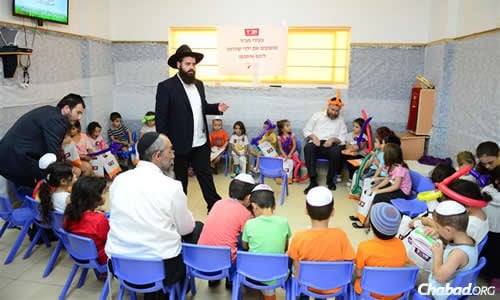
Keeping children happy in Sderot under the constant threat of rockets from Gaza.
Yesod Hama’ala
Up in the Hula Valley, Yesod Hama’ala—founded in 1882 and considered the first “modern” Jewish community in Israel—takes its name from the Tanach: “He (Ezra) determined to go up.” (Ezra 7:9). It is comprised of sabras for the most part, with Chabad there directed by Rabbi Yaakov and Bracha Reitzes.

Yesod HaMa'ala is located in the Hula Valley between Kiryat Shmona and Safed.
The rabbi came from Brooklyn about 40 years ago, in 1976, as part of a wave of yeshivah students and young married couples sent by the Rebbe to Israel. They were then to settle themselves in the Holy Land. In 1981, Reitzes wrote to the Rebbe about Yesod Hama’ala about receiving a blessing to establish himself in this town, which numbers about 700 families.
“When we got here, I believe we were the only shomer Shabbat family, and it took a while to become a part of the community,” he acknowledges. “But today, come see our Lag BaOmer celebration and witness a thriving community that can’t wait to join in the festivities.”
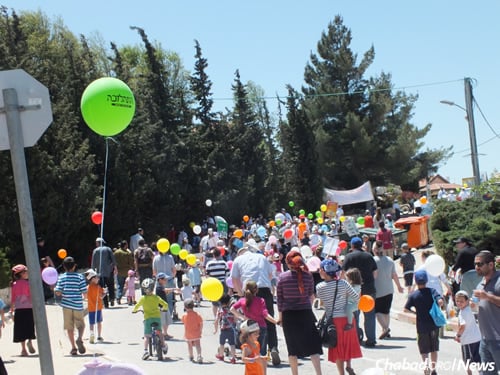
Last year in Yesod Hama'ala, little pieces of paper were distributed to children, who were asked to write down what they would like G-d to provide for them. They stuck those wishes to balloons that were then released into the air.
“We have, conservatively speaking, more than 150 children that come from town, neighboring kibbutzim and moshavim, and other small communities in the area to participate in the annual Lag BaOmer parade. Then they enjoy storytellers, magicians, musical performances and skits—not to mention good food and special events.”
Last year, little pieces of paper were distributed to all the children, who were asked to write down what they would like G‑d to provide for them. They then stuck those wishes to balloons that were released into the air. The kids literally saw their personal prayers fly upward, higher and higher to the heavens, each child’s own direct bond with G‑d.
“Although we look to increase Ahavat Yisrael [‘love of the Jewish people’] and Jewish unity every day of the year, on Lag BaOmer it is the focal point of the day. And when this takes place during the communal rejoicing of the Hakhel year, we can see all throughout the country how strong and loving and supportive we can be to each other.”

Kids from kibbutzim and moshavim in the Hula Valley come to Yesod HaMaalah to celebrate Lag BaOmer with Chabad.
Kiryat Shmona
Up north near the Lebanese border sits a city that has seen its fair share of military action. During that time—29 years, in fact—Chabad emissaries Rabbi Yigal and Irit Tzipori have worked hard and become beloved by the community.
According to the rabbi, Kiryat Shmona is comprised of mostly native-born Israelis, with about 20 percent originally from the former Soviet Union and a few Anglos thrown in for good measure.

The parade in Kiryat Shmona
“Every year, I would say we see at least 1,000 children in kindergarten through eighth grade at the celebration, with at least 200 who participate in the parade,” says Tzipori. “We see kids coming from all of the area schools to join, even during times of war.”
During a more recent embroilment with Lebanon—amid the wailing sirens and falling rockets, this time from Hezbollah—the Israel Defense Forces forbade residents from going outside, recounts the rabbi. People were given specific time frames to leave the shelters. But on Lag BaOmer, the army brought in soldiers to guard a playground for a few hours, where festivities took place—a parade and a raffle. Tzipori says that after the crowd returned to their shelters, “three Katushya rockets landed where we just had been. It was a Lag BaOmer miracle in many ways. One, that we had some downtime to celebrate, and two, that we all came out of it safe and whole.”
“This year, we expect nearly 1,000 children to gather at the Heichal Hatarbut [Hall of Culture], where there will be a circus, plays and skits, and even an MC who will relate the story of Lag BaOmer. Our kids come from all walks and backgrounds of Jewish life—from the entire gamut of Torah observance. And this year being the Hakhel year, it will be not only appropriate, but quite natural, that the main emphasis will be on Jewish unity and love of a fellow Jew.”
Be’er Sheva
Chabad emissaries Rabbi Zalman and Bela Gorelik have lived in the largest city in the Negev for the past 25 years, helping the desert bloom spiritually.
The rabbi says the majority of residents were of North African descent until the influx of Russian immigrants in the 1990s. He himself was born in Russia.
“We have a wonderful community here,” says Gorelik. “At Passover, we conducted our seder in 15 different languages so that everyone understands the Haggadah and the meaning of the service.”
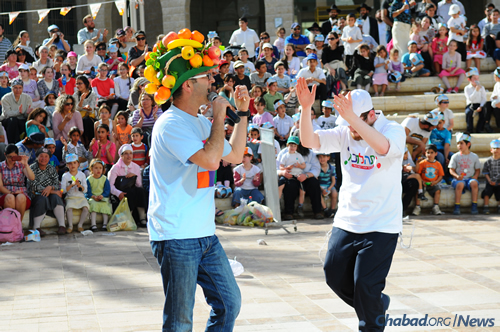
Lag BaOmer festivities in Be'er Sheva
Lag BaOmer comes with its own unique style. “First, the children go out and play in the fields, as was done traditionally. Then, we have a spirited parade—spirited because of all the little souls who fill it with their vitality,” he notes good-naturedly. Following that comes their special brand of offerings, including a theatrical production, raffle, singers and entertainment. The day is action-packed.
“We like to think that we have a little of the same atmosphere that you see up in Meron [the site of the Rashbi’s grave]. I guess you could call us the ‘Meron of the Darom [South].’ ”

A marching band at the Be'er Sheva parade
Safed
Ascent of Safed attracted 55,000 visitors from 25 countries last year, according to Rabbi Shaul Leiter, who with his wife, Chaya Brocha Baila, has co-directed the Chabad program since its inception in the early 1980s. “Although Ascent was started in 1983, it didn’t have its real beginning until 1984, after we received a letter from the Rebbe.”
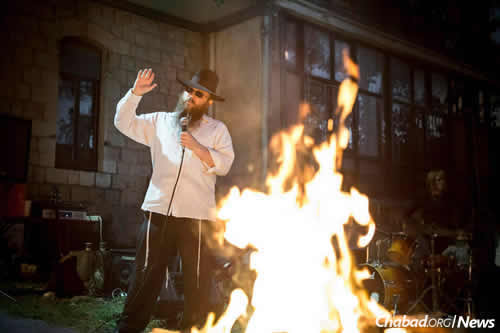
A bonfire at Ascent in Safed
The rabbi, who hails from Flatbush, N.Y., and his wife, from Colorado, relish this unique experience, where tourism and education go hand in hand.
“Of the 250,000 people that come to the nearby town of Meron on Lag BaOmer, only 10 percent are from overseas,” estimates Leiter. “The great majority are Chassidim from all over the country and the world, andSephardim, who have a masoret [tradition] to be by Rabbi Shimon.
“When a tzadik, a righteous person, reveals a great deal of spiritual light for humankind, such as the Rashbi, it makes a lasting impression on the very universe. Every year on the anniversary of their death, that tzadik’s soul comes back to our world, and their energy is available to help us. As such, it is upon us to increase our awareness of what we can receive on this day by studying something that tzadik revealed,” explains the rabbi.
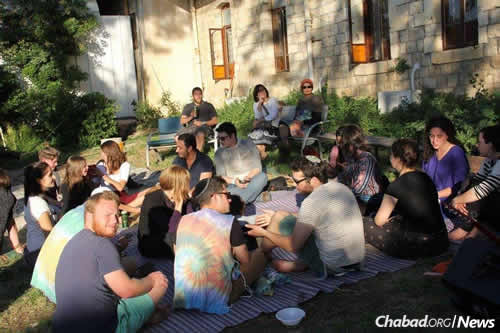
Some 55,000 visitors from throughout the world study at Ascent over the course of the year. Many of them join the 250,000 who gather in nearby Meron on Lag BaOmer.
“It also adds a great deal of strength to our prayers and our ability to ‘plug in’ to the tzadik when we can actually touch his grave—absorbing the energy that becomes available to us on this day of the anniversary of his death.”
Many of those traveling to Meron for the holiday stay in Safed, which is only a few miles away. Ascent runs classes, especially for first-timers, on what to look for, learn and experience at the gravesite of the Rashbi. Ascent staff will be hosting their own classes and festivities during the holiday, and staff will join students in Meron during the night and day.
“The holy city of Safed was the home of our most enlightened Kabbalists,” says Leiter. “It is important that people be able to go to the gravesite and remained focused on why they are there.”
On Lag BaOmer, thousands of 3-year-old boys are brought to Meron for their first haircut, as part of a ceremony called an upsherin. There are alsofarbrengens, Torah classes and giant screen that display videos of the Rebbe.
Says a knowing Leiter: “The better prepared a person is for this experience, the more he will get out of it. As it was asked in the Talmud: What is more important, the beginning or the end? There were those who argued the beginning; others said it was the end. The answer is that in order to obtain the ends we seek, we need to start with a good beginning to keep us from getting distracted.”

JEWISH NEWS

Israel’s All Fired Up for Lag BaOmer Festivities
More than 900 Chabad-Lubavitch emissary families in every corner of Israel are gearing up to host Lag BaOmer parades and festivities for all ages and segments of the population. by Sarah Leah Lawent
First, a Lag BaOmer parade, and then festivities for the entire family, as seen here in Be’er Sheva. (Photo: Yisrael Blesovsky)
Lag BaOmer is a day of rejoicing and celebration for Jews around the world. But in Israel there is a special ta’am, or “flavor,” as Jews of all ages and backgrounds gather together throughout the country—at night and into the day—in festive displays of Jewish unity and joy.
Each year, most of the more than 900 Chabad-Lubavitch emissaries in communities large and small around Israel are involved in planning and conducting events for the holiday, which begins this year on the evening of Wednesday, March 25, and lasts through evening on Thursday, May 26.
Children are the focal point of the activities, with Lag BaOmer day parades, carnivals, raffles, skits, singers, bow-and-arrow games, bonfires and cookouts in place to entertain them alongside their parents.
Lag BaOmer marks the 33rd day of thecounting of the Omer—the biblical imperative to count the 49 days between Passover, when the Israelites departed from Egypt, toShavuot, the date of the giving of the Torahat Sinai.
Special mourning practices are in effect during the Omer period to commemorate the passing of 24,000 students of the great sageRabbi Akiva, who were struck by a plague. During this time, Jews refrain from cutting hair; listening to music; and holding weddings and other simchas. These practices are suspended on Lag BaOmer, which thus becomes a day infused with joy.
It is also the yahrzeit, or anniversary of the passing, of the Rashbi—Rabbi Shimon bar Yochai, author of the Zohar—and the day that he instructed his students to embody and celebrate Jewish unity.
In 1953, in order to further instill a sense of Jewish pride and to inculcate brotherly love in each child, the Lubavitcher Rebbe—Rabbi Menachem M. Schneerson, of righteous memory—initiated the practice of parades on Lag BaOmer. When the holiday fell on a Sunday, the Rebbe himself would address thousands of children from a podium set up in front of 770 Eastern Parkway, Lubavitch World Headquarters in the Crown Heights neighborhood of Brooklyn, N.Y.
In Israel, entire towns gather together for this special holiday. And this year, in particular, Chabad emissaries are preparing for record crowds celebrating theHakhel year, a time when Jewish unity and learning are especially encouraged. It’s a veritable double dose of rejoicing in 5776.
Neve Daniel
In the relatively new community of Neve Daniel, founded in 1982 and located in Gush Etzion (south of Jerusalem and west of Bethlehem), Chabad co-directors Rabbi Baruch and Chaya Farber have poured their time, energy and caring into the community for the past four years. The Farbers come from families of emissaries; his parents live and have served the community in Gilo for 35 years, while she grew up in Dimona in the Negev Desert, where her parents serve as emissaries.

Neve Daniel is located in Gush Etzion, between Jerusalem and Hebron.
“When we arrived here, there was basically a very small Chabad community of several Russian immigrants,” explains the rabbi. Housing was difficult, but they managed to procure a trailer where they would pray and conduct their spiritual lives. There was not much communication between this community and the general community. We worked hard to develop lessons, Chassidicfarbrengens and weekly activities for the children.
“I would say that maybe 70 percent of the 2,500 people who live here are American in origin. You can walk around the schools and playgrounds, and hear English being the predominant language spoken. And today,” the rabbi continues, “the larger community of Neve Daniel is extremely supportive of Chabad—a full-fledged partner, one might say. The community itself not only participates in the activities we have set up, but provides us with a budget. It is a community that footed most of the bill for the construction of our newChabad House, which opened just last year.”

The parade in Neve Daniel brings out the entire community.
Sderot
Living in Israel’s south on the border with Hamas-controlled Gaza—where residents have about 15 seconds to find a bomb shelter or protected area when the Code Red rocket alarm system sounds—residents of Sderot have good reason to avoid outdoor gatherings. But not on Lag BaOmer.
Chabad emissaries Rabbi Moshe Ze’ev and Sima Pizam know that this day is exceptional. They have known that for the 30 years they have lived there.

Sderot, circled, sits next to the Gaza border. Beer Sheva is located at the bottom center.
“Although we have native-born Israelis here and residents who are immigrants from North Africa, North America and other countries, perhaps 50 percent of the populace is comprised of those who came in from the USSR and Ukraine,” reports the rabbi. “For a city on the border, where you might think people wouldn’t come to live, one of our biggest worries is being able to build fast enough to accommodate all those who show interest in moving here.
“On Lag BaOmer,” he continues, “families sit together for communal meals and barbecues, enjoy musical performances, plays, and, of course, the parade the children participate in. In past years, we have had 700 to 800 people come to our events; this year, we expect even more. After all, it is theHakhel year, when we emphasize Jewish unity even more.”
If rockets do fall—and safety is at stake—festivities are moved indoors. Sometimes, the parade wasn’t able to take place. But theirs is a steadfast lot, and time has tested the breadth of their bravery.
“The faith of and unity between Jews here in Sderot,” attests Pizam, “is a thing of wonder to behold.”

Keeping children happy in Sderot under the constant threat of rockets from Gaza.
Yesod Hama’ala
Up in the Hula Valley, Yesod Hama’ala—founded in 1882 and considered the first “modern” Jewish community in Israel—takes its name from the Tanach: “He (Ezra) determined to go up.” (Ezra 7:9). It is comprised of sabras for the most part, with Chabad there directed by Rabbi Yaakov and Bracha Reitzes.

Yesod HaMa'ala is located in the Hula Valley between Kiryat Shmona and Safed.
The rabbi came from Brooklyn about 40 years ago, in 1976, as part of a wave of yeshivah students and young married couples sent by the Rebbe to Israel. They were then to settle themselves in the Holy Land. In 1981, Reitzes wrote to the Rebbe about Yesod Hama’ala about receiving a blessing to establish himself in this town, which numbers about 700 families.
“When we got here, I believe we were the only shomer Shabbat family, and it took a while to become a part of the community,” he acknowledges. “But today, come see our Lag BaOmer celebration and witness a thriving community that can’t wait to join in the festivities.”

Last year in Yesod Hama'ala, little pieces of paper were distributed to children, who were asked to write down what they would like G-d to provide for them. They stuck those wishes to balloons that were then released into the air.
“We have, conservatively speaking, more than 150 children that come from town, neighboring kibbutzim and moshavim, and other small communities in the area to participate in the annual Lag BaOmer parade. Then they enjoy storytellers, magicians, musical performances and skits—not to mention good food and special events.”
Last year, little pieces of paper were distributed to all the children, who were asked to write down what they would like G‑d to provide for them. They then stuck those wishes to balloons that were released into the air. The kids literally saw their personal prayers fly upward, higher and higher to the heavens, each child’s own direct bond with G‑d.
“Although we look to increase Ahavat Yisrael [‘love of the Jewish people’] and Jewish unity every day of the year, on Lag BaOmer it is the focal point of the day. And when this takes place during the communal rejoicing of the Hakhel year, we can see all throughout the country how strong and loving and supportive we can be to each other.”

Kids from kibbutzim and moshavim in the Hula Valley come to Yesod HaMaalah to celebrate Lag BaOmer with Chabad.
Kiryat Shmona
Up north near the Lebanese border sits a city that has seen its fair share of military action. During that time—29 years, in fact—Chabad emissaries Rabbi Yigal and Irit Tzipori have worked hard and become beloved by the community.
According to the rabbi, Kiryat Shmona is comprised of mostly native-born Israelis, with about 20 percent originally from the former Soviet Union and a few Anglos thrown in for good measure.

The parade in Kiryat Shmona
“Every year, I would say we see at least 1,000 children in kindergarten through eighth grade at the celebration, with at least 200 who participate in the parade,” says Tzipori. “We see kids coming from all of the area schools to join, even during times of war.”
During a more recent embroilment with Lebanon—amid the wailing sirens and falling rockets, this time from Hezbollah—the Israel Defense Forces forbade residents from going outside, recounts the rabbi. People were given specific time frames to leave the shelters. But on Lag BaOmer, the army brought in soldiers to guard a playground for a few hours, where festivities took place—a parade and a raffle. Tzipori says that after the crowd returned to their shelters, “three Katushya rockets landed where we just had been. It was a Lag BaOmer miracle in many ways. One, that we had some downtime to celebrate, and two, that we all came out of it safe and whole.”
“This year, we expect nearly 1,000 children to gather at the Heichal Hatarbut [Hall of Culture], where there will be a circus, plays and skits, and even an MC who will relate the story of Lag BaOmer. Our kids come from all walks and backgrounds of Jewish life—from the entire gamut of Torah observance. And this year being the Hakhel year, it will be not only appropriate, but quite natural, that the main emphasis will be on Jewish unity and love of a fellow Jew.”
Be’er Sheva
Chabad emissaries Rabbi Zalman and Bela Gorelik have lived in the largest city in the Negev for the past 25 years, helping the desert bloom spiritually.
The rabbi says the majority of residents were of North African descent until the influx of Russian immigrants in the 1990s. He himself was born in Russia.
“We have a wonderful community here,” says Gorelik. “At Passover, we conducted our seder in 15 different languages so that everyone understands the Haggadah and the meaning of the service.”

Lag BaOmer festivities in Be'er Sheva
Lag BaOmer comes with its own unique style. “First, the children go out and play in the fields, as was done traditionally. Then, we have a spirited parade—spirited because of all the little souls who fill it with their vitality,” he notes good-naturedly. Following that comes their special brand of offerings, including a theatrical production, raffle, singers and entertainment. The day is action-packed.
“We like to think that we have a little of the same atmosphere that you see up in Meron [the site of the Rashbi’s grave]. I guess you could call us the ‘Meron of the Darom [South].’ ”

A marching band at the Be'er Sheva parade
Safed
Ascent of Safed attracted 55,000 visitors from 25 countries last year, according to Rabbi Shaul Leiter, who with his wife, Chaya Brocha Baila, has co-directed the Chabad program since its inception in the early 1980s. “Although Ascent was started in 1983, it didn’t have its real beginning until 1984, after we received a letter from the Rebbe.”

A bonfire at Ascent in Safed
The rabbi, who hails from Flatbush, N.Y., and his wife, from Colorado, relish this unique experience, where tourism and education go hand in hand.
“Of the 250,000 people that come to the nearby town of Meron on Lag BaOmer, only 10 percent are from overseas,” estimates Leiter. “The great majority are Chassidim from all over the country and the world, andSephardim, who have a masoret [tradition] to be by Rabbi Shimon.
“When a tzadik, a righteous person, reveals a great deal of spiritual light for humankind, such as the Rashbi, it makes a lasting impression on the very universe. Every year on the anniversary of their death, that tzadik’s soul comes back to our world, and their energy is available to help us. As such, it is upon us to increase our awareness of what we can receive on this day by studying something that tzadik revealed,” explains the rabbi.

Some 55,000 visitors from throughout the world study at Ascent over the course of the year. Many of them join the 250,000 who gather in nearby Meron on Lag BaOmer.
“It also adds a great deal of strength to our prayers and our ability to ‘plug in’ to the tzadik when we can actually touch his grave—absorbing the energy that becomes available to us on this day of the anniversary of his death.”
Many of those traveling to Meron for the holiday stay in Safed, which is only a few miles away. Ascent runs classes, especially for first-timers, on what to look for, learn and experience at the gravesite of the Rashbi. Ascent staff will be hosting their own classes and festivities during the holiday, and staff will join students in Meron during the night and day.
“The holy city of Safed was the home of our most enlightened Kabbalists,” says Leiter. “It is important that people be able to go to the gravesite and remained focused on why they are there.”
On Lag BaOmer, thousands of 3-year-old boys are brought to Meron for their first haircut, as part of a ceremony called an upsherin. There are alsofarbrengens, Torah classes and giant screen that display videos of the Rebbe.
Says a knowing Leiter: “The better prepared a person is for this experience, the more he will get out of it. As it was asked in the Talmud: What is more important, the beginning or the end? There were those who argued the beginning; others said it was the end. The answer is that in order to obtain the ends we seek, we need to start with a good beginning to keep us from getting distracted.”
-------

Storied Chabad Couple Honored for the First Time After 55 Years in Minnesota
Recognizing decades of inspiration by Rabbi Moshe and Mindelle Feller. by Menachem Posner
Rabbi Moshe Feller, left, outside Lubavitch House at 15 Montcalm Court, where Bais Chana—the world-renowned educational institute for women—was born.
It’s been 55 years since Rabbi Moshe and Mindelle Feller set out to found Upper Midwest Merkos–Chabad Lubavitch in Minnesota in the winter of 1961, a mere month after their marriage. Now, for the first time in a career that has spanned 10 U.S. presidencies and countless meaningful interactions, the couple has agreed to be honored at a gala dinner of the Lubavitch ChederDay School, which the couple founded 39 years ago in St. Paul.
“Before my wife and I moved out to Minnesota, we had a private audience with the Rebbe [Rabbi Menachem M. Schneerson, of righteous memory],” recalls the rabbi, now 79. “The Rebbe spoke mostly to my wife. However, among other things, the Rebbe told me—and he said this word in English—that I would need to be ‘flexible.’ ”
The rabbi credits that flexibility with his ability to constantly adapt and innovate during his and his wife’s long and fruitful career.
It was that flexibility that inspired him to visit Sandy Koufax in his in his St. Paul hotel room the morning after the Jewish southpaw famously sat out of a game during the 1965 World Series. Feller congratulated Koufax for not playing on Yom Kippur, and for “the great assist he gave rabbis and Jewish educators the world over.”
He also brought the Brooklyn, N.Y.-born pitcher a pair of tefillin.
Growing up in the 1940s, there was no Jewish day school in Minnesota for the young Moshe Feller to attend. Like most of his peers, he learned basic Hebrew literacy at an after-school program and learned by example through observing his parents. His father was a car salesman who never worked onShabbat, which was a rarity in those days.
‘Dedication to Tradition’
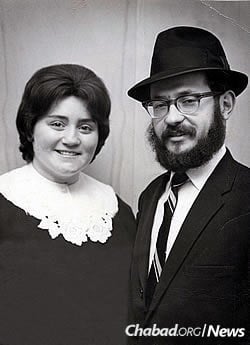
Rabbi Moshe and Mindelle Feller
As a young teenager, he was sent by his parents to learn in a yeshivahin New York, an opportunity his father had never had.
There, he became attracted to the Rebbe and Chabad, and came to learn in the Chabad yeshivah at 770 Eastern Parkway in Brooklyn.
After the Fellers married, they eagerly looked forward to beginning their career together as emissaries of the Rebbe. Since he had previously found success as a “Roving Rabbi” in Mexico, the young rabbi expected to be sent there. “The last place in the world I wanted to go was back to Minnesota,” he recalls. “But the Rebbe told us that he wanted us to go there to establish Chabad in the Upper Midwest, and we went with joy.”
Upon their arrival, it was the flexibility the Rebbe spoke about that inspired the young couple to begin their work in the Twin Cities of Minneapolis-St. Paul, with the firm resolve not to duplicate the existing Jewish infrastructure in the city.
They started by traveling to small towns that had no organized Jewish life, arranging Hebrew schools, adult-education classes and holiday programs for the Jews they found there. That first year, they also arranged special father-and-son Shabbat services in their home for Holocaust survivors and their sons, many of whom were approaching bar mitzvah age.
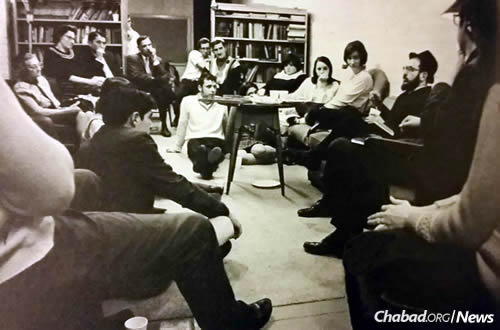
The rabbi holds a conversation with young adults in Minnesota.
By 1963, they had founded what may have been the first Gan Israel day camp in history, a success that has been replicated in hundreds—if not thousands—of cities around the world.
The rabbi is quick to point out that “flexibility” does not mean religious compromise. In fact, it is his unwavering fealty to Jewish belief and practice that has endeared him to Minnesotans.
“In a world of moral relativism, you can count on Rabbi Feller to be a bedrock of eternal Jewish values,” says former U.S Senator Rudy Boschwitz, who first met the rabbi in 1963 and has maintained a life-long relationship with him. “Rabbi Feller, and Lubavitch as a whole, is very impressive to me because of their firm beliefs. I like that very much.”
The two met when Feller came to Boschwitz’s lumber store in search of supplies to build a sukkah. “In those days, black hats and beards were not uncommon,” recalls the former senator, who was born in Germany and came to the U.S. with his parents as a 4-year-old. “But he was wearing tzitzit, which was unique. I offered to sponsor the supplies. Little did I know just how ambitious this rabbi was about sukkah-building. Before I knew it, I was thesukkah king of Minnesota.”
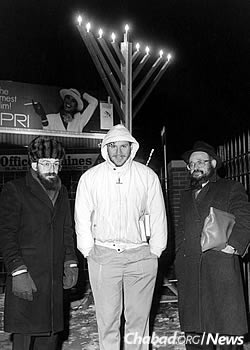
Feller stands in front of one of the early giant menorahs with Rabbi YosefShagalow, left, and a younger member of the community.
When Boschwitz was elected to the U.S. Senate in 1978, it was natural that he would invite “his” rabbi to open the senate session, something Feller went on to do eight times. Yet, despite walking in the halls of power (he has been invited to the Oval Office more than a dozen times) and rubbing shoulders with celebrities (Minnesota native Bob Dylan was known to frequent the rabbi’s services and events), locals say the Fellers remain dedicated to all Jewish community members and the principal duties at hand: teachingTorah, helping people performmitzvahs, and providing a listening ear and a hot meal to those in need.
“The Fellers have a heart like that of King David, which encompassed all of Israel,” says Rabbi Moshe Tuvia Leiff, who served as rabbi of CongregationBais Yisroel of Minneapolis for two decades before moving to New York. “Rabbi Feller crosses all barriers, and does whatever he can to be a positive influence and a help to everyone he meets.
“On one hand, he has an uncompromising dedication to tradition. At the same time, he packages things in such a way that anyone can accept and appreciate,” explains Leiff. “I would say that he has been both in the box and out of the box for decades—and the results are the many innovative programs that have benefited world Jewry.”
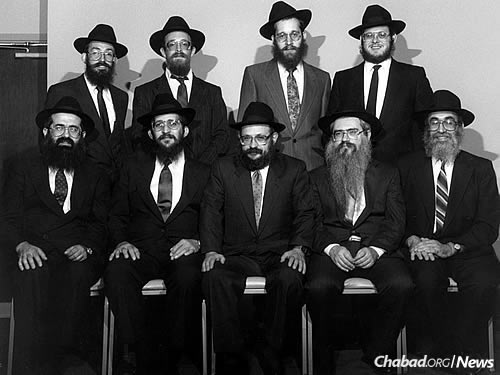
At a gathering of area Chabad-Lubavitch shluchim. Seated, from left: Rabbi Gershon Grossbaum, Rabbi Moshe Kasowitz, Rabbi Moshe Feller, Rabbi Manis Friedman and Rabbi Shlomo Bendet. Standing, from left: Rabbi Yosef Shagalow, Rabbi Mendy Lew, Rabbi Mendel Katzman and Rabbi Dovid Greene.
That same mix is what brought the late Professor Velvl Greene to Jewish observance. In 1963, Feller had sought out Greene—then a rising star in the Minnesota Jewish scene—to lend his name to the rabbi’s first banquet.
Having requested an appointment with the professor, the rabbi suddenly realized that the sun was about to set and he had not yet said the afternoon prayers. “Disregarding the fact that he is in my office, that he had asked for the appointment, that he is requesting a favor—he stands up, walks to the wall, ties a black cord around his waist, and proceeds to mumble and shake,”recalled the professor, who passed away in 2011. “There were a lot of things I didn't know then. But I did develop a definite interest and a special affection for this young man who was so pleasant and so different. He had a completely different set of rules to guide him—at once so radical and so archaic. He not only marched to the beat of a different drum—he seemed to enjoy the music more than we did ours. If he tried to influence us, during those early months, it must have been a very subtle effort.”
In time, through their connection to the Fellers and to the Rebbe, the Greenes and their children adopted a fully Jewish lifestyle.
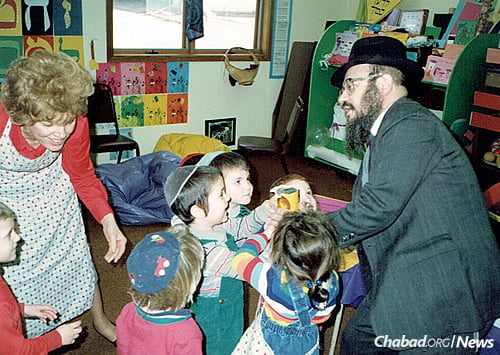
Rabbi Feller helps children in the Cheder perform the mitzvah of tzedakah.
‘One Smile at a Time’
Over their 55 years of communal service, the Fellers’ operation has evolved and grown.
After two years of living in the rabbi’s father’s house in Minneapolis (his mother had passed away), the Fellers moved to neighboring St. Paul. All the Orthodox synagogues had since closed, and there was a need for services and programming.
In 1965, the Fellers opened the Lubavitch House in a 12-room home. Then an innovation, it served as a retreat for Shabbat and other Jewish gatherings. Through their efforts a year later, Rabbi Asher Zeilingold was brought in to serve as rabbi at the revitalized Adath Israel Congregation, a position he has now held for 50 years and counting.
When the Lubavitch House was burned by arsonists in 1968, the Fellers buried the Torahs and went on to purchase a mansion in Highland Park. In 1971, together with Rabbi Manis Friedman, the Fellers founded Bais Chana—the world-renowned educational institute for women seeking to learn about Judaism—which today boasts some 20,000 alumnae. In 2000, Chabad again relocated to a new 23,000-square-foot facility in West St. Paul.
More than a decade later, in 1977, the time came to found a Chassidic day school in St. Paul, and Lubavitch Cheder Day School was born, with Mrs. Feller serving as founding principal.
Today, under the directorship of Rabbi Shlomo Bendet, the school continues to thrive as a bastion of Jewish education and excellence.
“When we look to celebrate the ideals and the inspiration of the Lubavitch Cheder, it is clear that the best way to do so is by showcasing the Fellers,” states Rabbi Yossi Bendet, director of development. “Genuine Chassidim, they have touched countless people and have made a world of a difference, one smile at a time.”
Click here to place an ad, reserve a space or learn more about the gala dinner, which will take place on Sunday, May 22 (Pesach Sheini) in downtown Minneapolis.
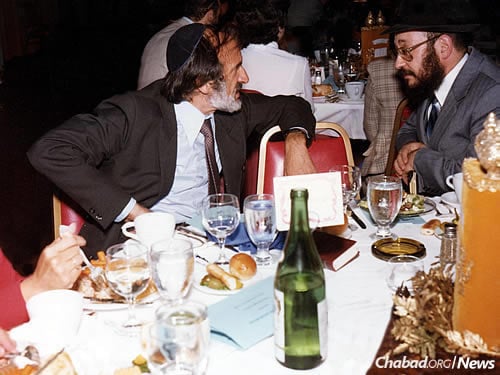
Feller in conversation with Elie Wiesel
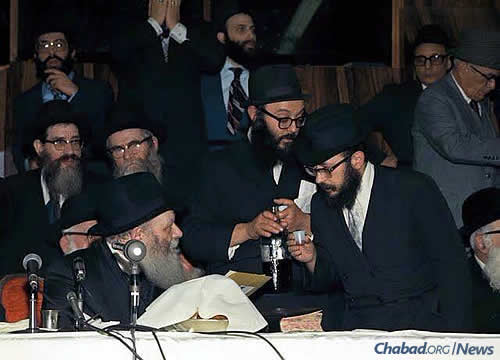
The rabbi approaches the Rebbe for a private word and a “l’chaim” during a farbrengen in the 1970s.
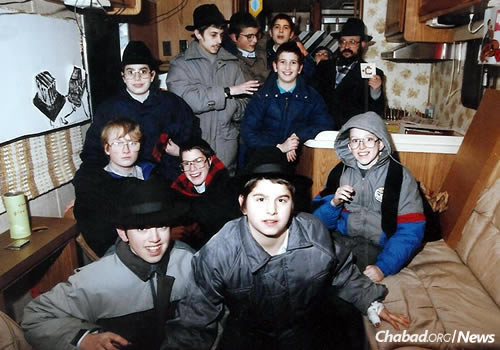
Feller with a group of Cheder students in a “mitzvah tank,” getting ready to bring a little Jewish warmth into the Minnesota cold.

The exterior of the Lubavitch Cheder Day School in St. Paul.
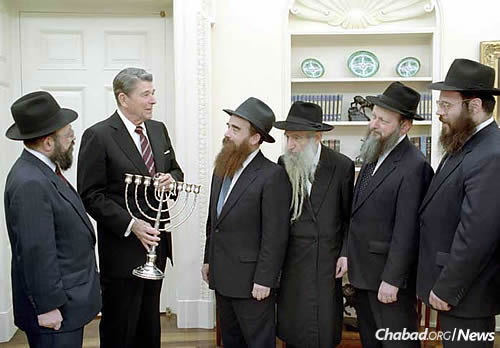
With President Ronald Reagan in the White House at Chanukah time are, from left: Rabbi Moshe Feller, Rabbi Avraham Shemtov, Rabbi Shmuel Dovid Raichik, Rabbi Moshe Herson and Rabbi Yossi Groner.
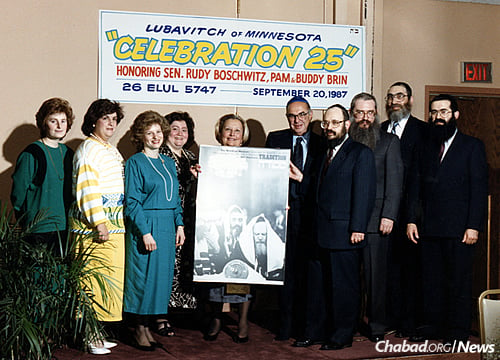
The Fellers and other local leaders at a 25th Jewish communal celebration in 1987.

Today, Bais Chana boasts some 20,000 alumnae.
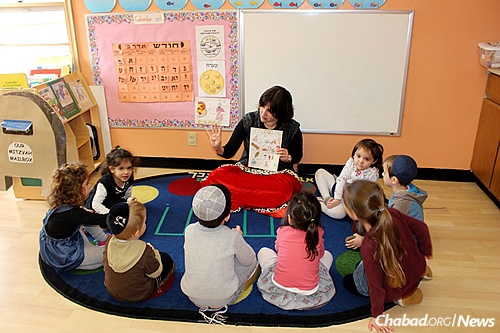
Young children learn at the Lubavitch Cheder Day School in St. Paul.

Older students at the Chassidic day school, which was founded in 1977.

Kids make Chanukah dreidels from wood at a local Home Depot holiday workshop.

-------

Soviet Jewish Underground Rabbi to Receive Honor at U.S. Senate
The acclaimed author and activist tells a story of survival and assistance for fellow Jews. by Dovid Margolin
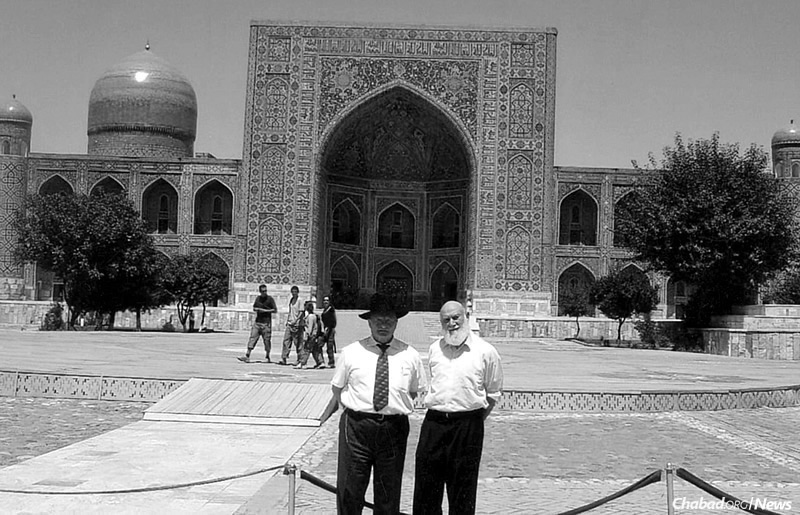
Rabbi Hillel Zaltzman, right, with his brother Rabbi Berel Zaltzman during a visit to Samarkand, Uzbekistan, the city they grew up in and left in 1971.
Growing up and coming of age in the Soviet Union, it’s unlikely that RabbiHillel Zaltzman could have ever imagined being honored in Washington, D.C., as part of Jewish American Heritage Month.
But that’s exactly what Zaltzman, president of Chamah International, will experience when he is honored on Wednesday, May 25, for his humanitarian and Jewish outreach work at a luncheon on Capitol Hill.
“We never dreamed we’d ever even be allowed to leave,” says Zaltzman. “Never mind be honored in the United States Senate!”
His is a story that has captivated thousands since he published his memoir, Samarkand, last year in Hebrew, English and Russian. Much of the early part reads similarly to other World War II-era recollections—born in Kharkov, Ukraine, in 1939, his family fled the Nazi invasion when he was just a toddler, heading east to Samarkand, Soviet Asia. Relatives who stayed behind ultimately perished.
But it was there, in Uzbeki Samarkand, that a Chabad-Lubavitch Chassidic community established itself. And it’s on this little known but important chapter of Soviet Jewish history that Zaltzman’s widely acclaimed book sheds much light, revealing a world within a world.
In Samarkand, the Chassidic Jews established synagogues and a yeshivah; held brit milahs, bar mitzvahs and weddings; and mourned the loss of loved ones at the front and at home. In 1946, a majority of this underground community escaped to the West by procuring false Polish papers and crossing the border out of the Soviet Union at Lvov (today, Lviv)—but some remained behind, including Zaltzman and his family. They remained in Samarkand for nearly another three decades, given permission to finally leave in 1971.
‘The Hardest of Conditions’
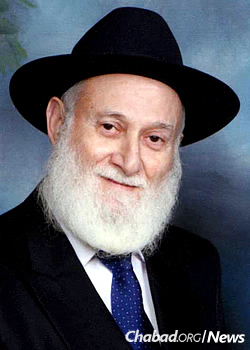
Rabbi Hillel Zaltzman
Many Soviet Jews who experienced the horrific years under Stalin—and then the state-sponsored anti-Semitism that followed during Nikita Khrushchev’s premiership, and everything in between—are surprised when they read Zaltzman’s memoirs, which recount an underground religious Jewish community that continued to exist through the 1950s, ’60s and ’70s, complete with a cheder, mikvah andmatzah bakery. That an active, secret Jewish community fueled by young people existed during those dark years came as news to them.
It was in the Soviet Union that Zaltzman and a small group of friends started Chamah, which they used to help their fellow Jews spiritually and materially—for example by procuring extra coal to heat their homes during the winter. Later, they began traveling throughout Uzbeki villages and reaching out to local Bukharian Jews, convincing them to send their children to Jewish schools and classes they were establishing in the area.
After his arrival in the United States, Zaltzman and his partners continued their work on behalf of Soviet Jewry, expanding Chamah’s operations to include medical aid, furthering Jewish education among Russian Jews in America and abroad, and establishing a publishing house.
“The honor does not only go to me, but to my parents, teachers and mentors, who raised us as religious Jews even in the hardest of conditions,” says Zaltzman. “This is an opportunity to say thank you to Jews and non-Jews alike who stood up for us in Russia. The Lubavitcher Rebbe [RabbiMenachem M. Schneerson, of righteous memory] often spoke about the founders of this country, who worked to establish refuge from religious persecution here. Since then, millions more found refuge here, as did I. This is a very great honor for me.”
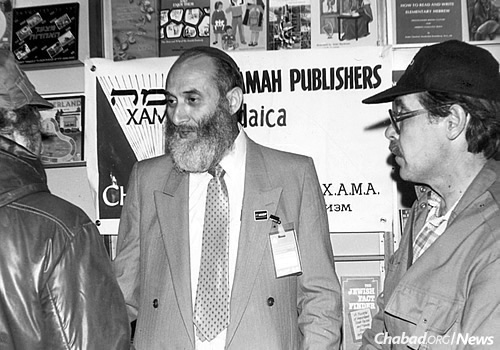
Rabbi Hillel Zaltzman at Chamah's Jewish book stand at a book fair in Moscow in 1989.
---------------------
Really nice and interesting post. I was looking for this kind of information and enjoyed reading this one. Keep posting. Thanks for sharing.books on meditation
ReplyDeleteThis blog is really great.Thank you.
ReplyDeleteDeep Sleep Meditation